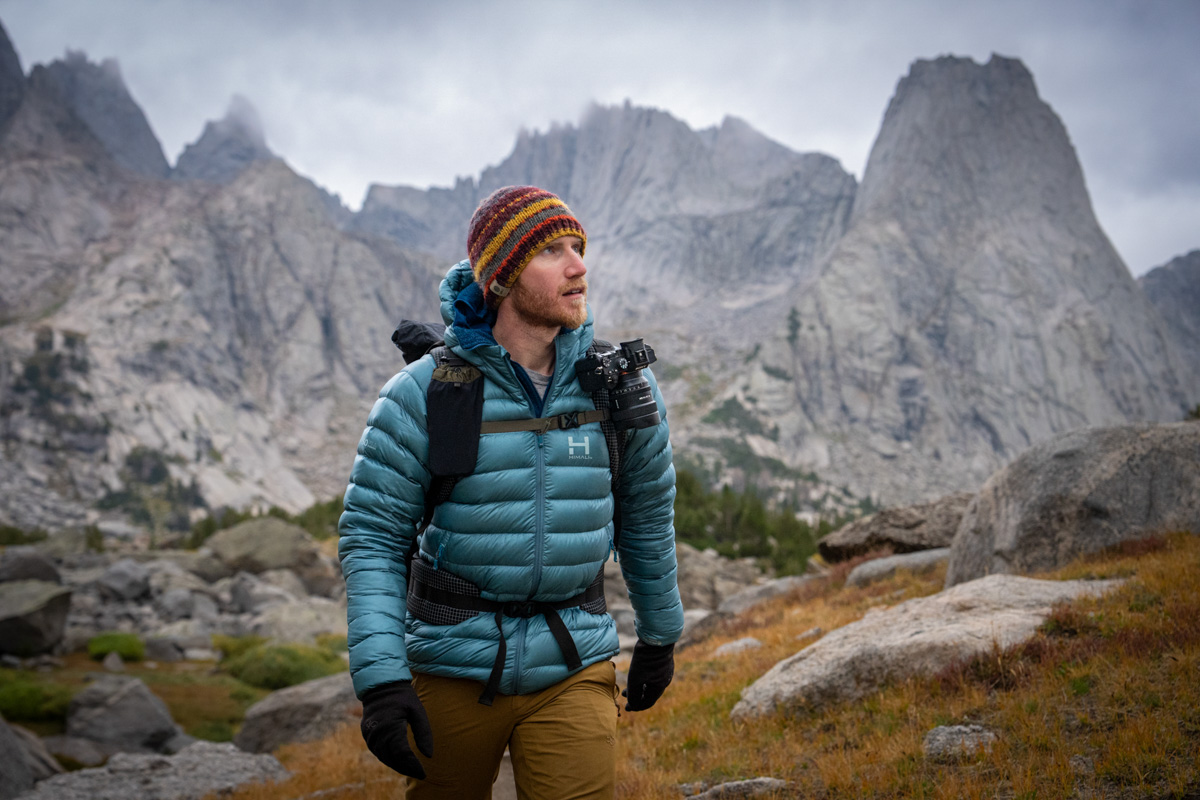
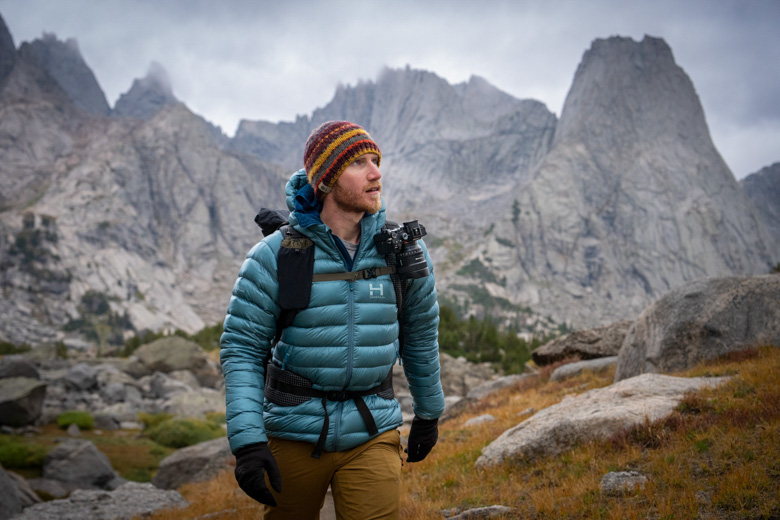
Switchback Travel (Jason Hummel)
Want to capture your trek in cinematic quality? With lighter, more streamlined cameras coming out each year, that's becoming an easier task—even for ultralight backpackers. While the iPhone's point-and-shoot capabilities improve with each update, there is simply no substitute for a solid, dedicated camera for snagging those perfect sunset shots or filming your experience. The best cameras for hiking and backpacking must be lightweight, durable, and capable of taking stellar shots without weighing you down—all while fending off some serious torture on the trail. Depending on your budget, the options abound in categories from compact point-and-shoots and mirrorless cameras to full-frame DSLRs. It’s not overly difficult to keep your camera protected from the elements with a simple dry bag and pack liner, but weather and dust-sealed cameras are available both in the “tough” category and on higher-end mirrorless cameras and DSLRs. For more information, see our comparison table and buying advice below the picks, as well as details about our testing practices.
Editor's note: We updated this guide on July 8, 2025, to add the Panasonic Lumix S9 and Canon EOS R50 V and to include new photos from recent testing trips. Keep in mind that the stated weights of interchangeable lens cameras below will increase (along with the overall price) based on the lens you select.
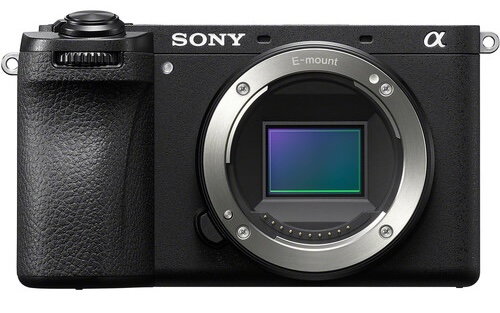 Weight: 1 lb. 1.4 oz. (base with battery and memory card)
Weight: 1 lb. 1.4 oz. (base with battery and memory card)
Megapixels: 26
Sensor: Exmor R APS-C BSI CMOS
What we like: Lighter than previous iterations; stellar quality in a compact, durable build; great for video; dust and moisture-sealed magnesium design.
What we don't: Expensive for beginners; frustrating menu layout; bit of a steep learning curve; battery life isn't the best.
In terms of quality-to-weight ratio, mirrorless cameras take the cake. They offer DSLR-like image sensors in compact bodies, are much lighter than DSLRs, and have better video quality, higher frame rates, and more advanced features to boot. This makes them prime picks for hiking photographers who are looking to expand their creative opportunities. Mirrorless cameras are larger than point-and-shoots but smaller than DSLRs, and APS-C (crop sensor) cameras keep bulk even lower. Sony's line of APS-C mirrorless cameras dominates the podium for hikers or backpackers looking to maintain a low base weight while capturing their journey in a professional style. Their newest iteration, the a6700, boasts too many impressive specs to list: a 26 MP sensor, AI-powered autofocus and image stabilization, UHD 10-bit 4K video up to 120p (oversampled from a 6K resolution) with S-Log and S-Cinetone profiles (amongst others), and expandable ISO sensitivity of 50-102,400 (100-32,000 for video) to name a few. Years ago, these specs were a pipe dream for a camera this light and tiny.
Our author has been a long-time fan of Sony's crop-sensor lineup. He's schlepped these APS-C beasts for thousands of miles along each trail of the Triple Crown and has put them through torture and torment while filming documentaries of each trek. He's gone through several iterations and lauds both their photo and video capabilities in such a lightweight, durable setup. Very few cons accompany Sony's a6000 series, but a few stand out. The frustrating and confusing menu layout is our biggest qualm—though we have this gripe with every Sony camera—which contributes to a steep learning curve. Additionally, at $1,398, it's very expensive for the beginner just breaking into photography. The good news is, the older versions are still readily available at a fraction of the cost. You can pick up something like the a6400 for $898, which boasts very similar capabilities. While a smaller camera (or just an iPhone) will suffice for basic shots, something like the a6700 will truly elevate your photo and video prowess in the midst of demanding romps across the country, or casual evening strolls alike.
See the Sony a6700 See the Sony a6400
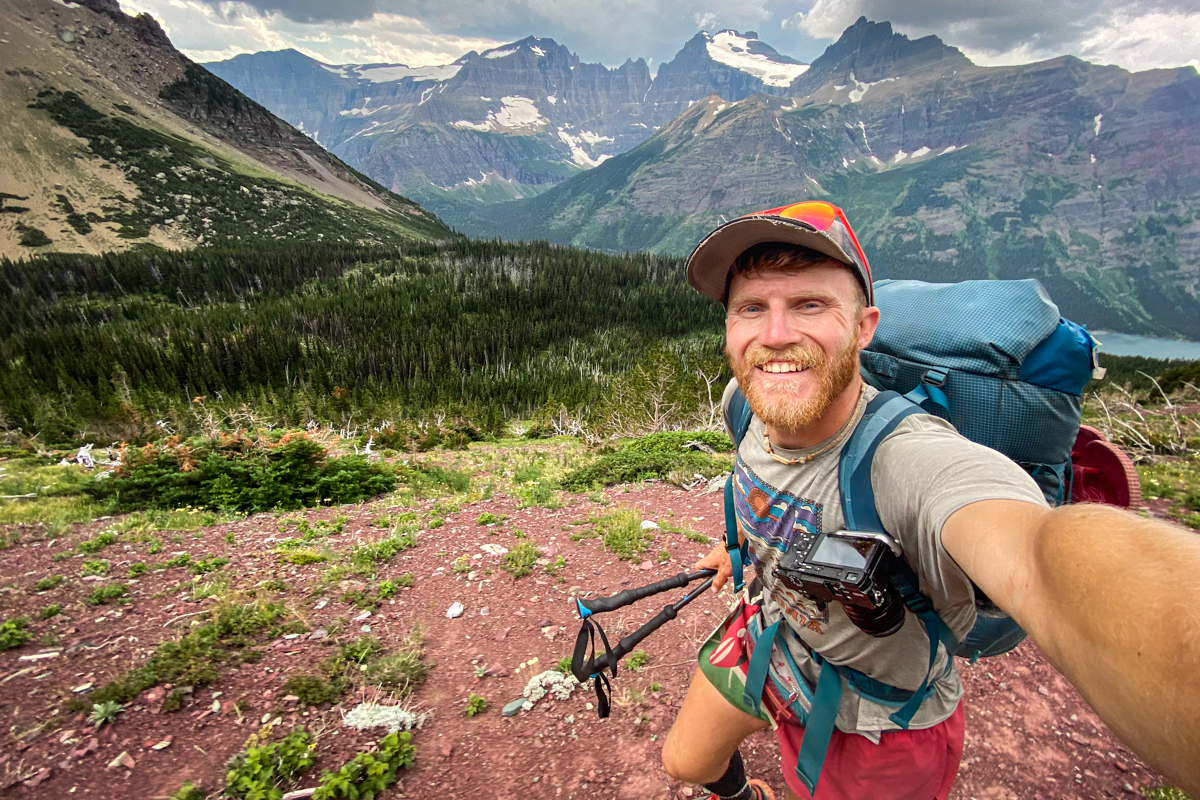
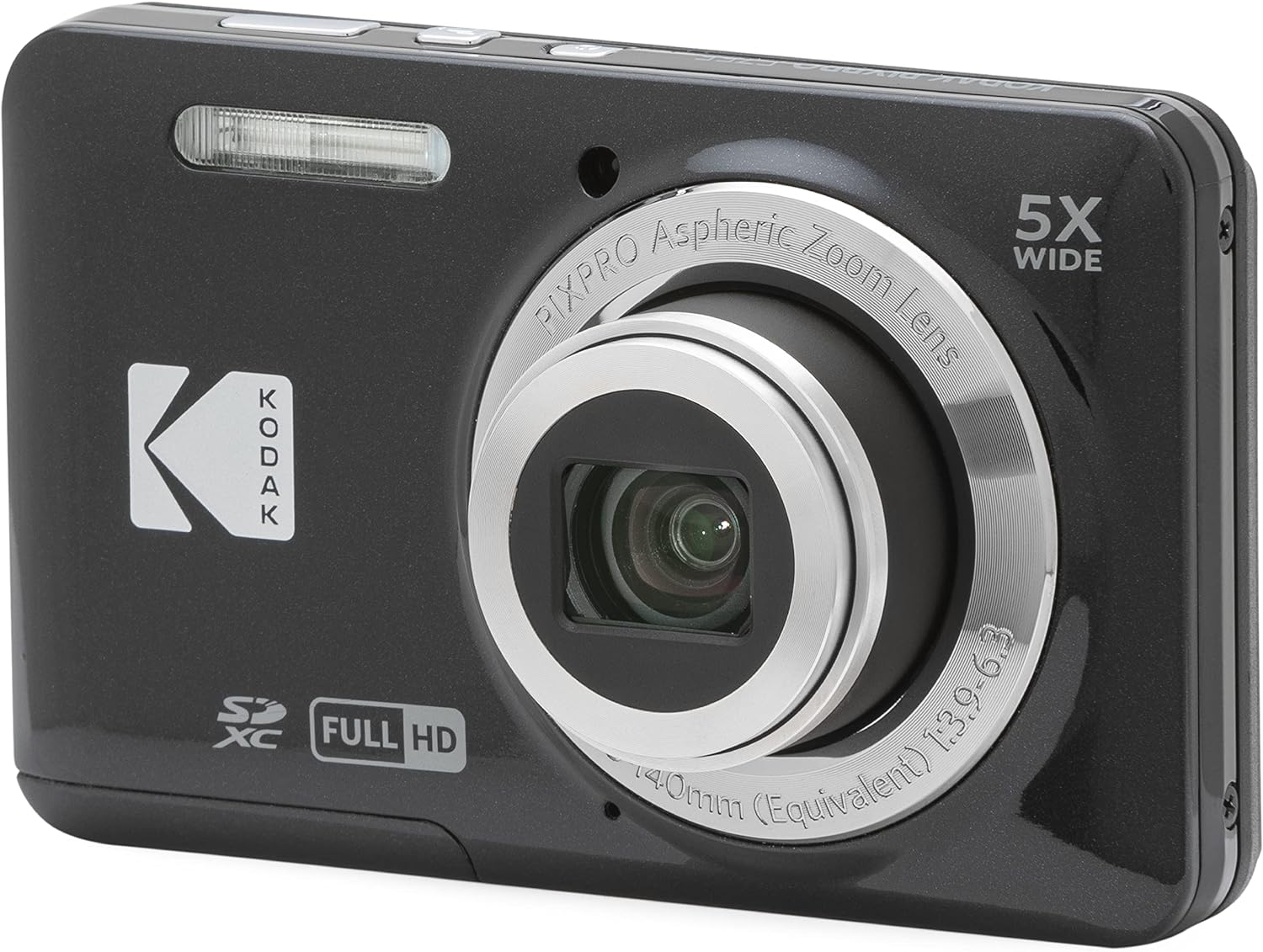 Weight: 3.7 oz.
Weight: 3.7 oz.
Megapixels: 16
Sensor: 1/2.3" CMOS
What we like: Stellar price; ultralight weight; smooth bokeh; solid zoom range; easy to function; large LCD screen.
What we don't: No built-in Wi-Fi or Bluetooth; low-resolution video; not the highest quality photos; no EVF.
While you probably won't end up on the cover of Nat Geo with a photo from this little credit card camera, it undeniably punches above its weight. At just 3.7 ounces, you can snag surprisingly quality photos—and even 1080p video—in a featherlight design and compact size that easily slides into your fanny pack or shoulder pocket. If you're looking for just the basics at the lowest price possible, the Pixpro FZ55 is a solid pick. With smartphone cameras improving each year, the traditional point-and-shoot market has perhaps been hit the hardest—so is it even worth it to carry something like this on the trail? We think so. With a 5x optical zoom, (28-140mm equivalent), and relatively smooth natural bokeh with an (albeit slow) aperture of f/3.9 to f/6.3, the FZ55 produces nice images that even the "portrait" mode of iPhones just can't compete with yet. The wide motorized zoom range, focus options (single AF, multi-AF, object tracking, and face detection), and acceptable ISO range (100-3,200) make it a functional powerhouse for such a low price.
You do have to pay the piper with a budget camera this cheap, unfortunately. Serious photography critics will notice downsides like converging verticals wide open at 28mm, noticeable sharpness fall-off into the corners of the frame, softer images in telephoto, and burnt-out highlights—but most people shopping for a sub-$200 camera aren't overly concerned with these specs. The ability to shoot full HD 1080p video up to 30 fps is a nice touch, but 1080p is quickly becoming obsolete in today's digital age. If you hope to do any serious filming on your trek, we would look elsewhere. Additionally, there is no built-in Wi-Fi or Bluetooth connectivity, meaning you have to carry a card reader to get photos on your phone in the backcountry or wait to transfer them over from your computer at home. This is a pretty big ding for backpackers wanting to share their content mid-journey. But all told, the Pixpro FZ55 is a stellar option for the penny-pinching trail-trotter who isn't after the highest quality photos—and doesn't plan to shoot a lot of video.
See the Kodak Pixpro FZ55
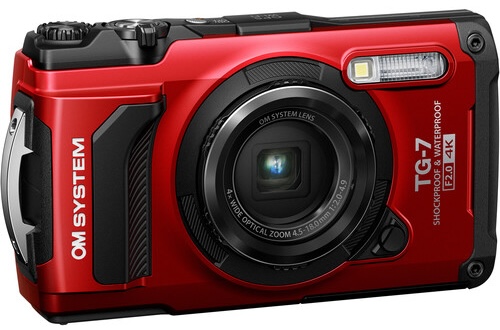 Weight: 8.8 oz.
Weight: 8.8 oz.
Megapixels: 12
Sensor: 1/2.3"-Type CMOS
What we like: Raw shooting; 4K video; invincible design; quality photos; built-in GPS, Wi-Fi, and Bluetooth; large array of accessories.
What we don't: Small sensor size; heavy compared to other point-and-shoots; pricey; most others on this list perform better.
If the Kodak Pixpro above is the Honda Accord of the point-and-shoot family, the OM SYSTEM Tough TG-7 is a bullet-proof tank. Let's get down to brass tacks with the specs of this beast: an IPX8 waterproof rating for underwater use to depths of 50 feet (with an Underwater White Balance mode), freezeproof to temperatures as low as 14°F, shockproof to drops from up to seven feet, crushproof up to 220 lbs of pressure, and extremely dustproof—this is about as indestructible as a camera gets. While many hikers and backpackers won't need such a stalwart design, this is a foolproof way to get high-quality content on gnarly bushwhacking expeditions, paddling excursions, or nail-biting alpine ascents. If you just don't want to have to worry about the elements at all on your trek, the TG-7 has your back. But does it perform? In our experience, the photos you can get with this camera are up there with some of the better point-and-shoots on the market. You can shoot raw, tweak manual controls, and capture a ton of light at the wide-angle end of the zoom, with a generous aperture of f/2.0. It even shoots 4K 30/24 fps video—which isn't incredible—but will get the job done for most hikers.
So what's the catch? A 12 MP sensor puts this squarely on the small fringe of the spectrum—even smaller than the budget Pixpro above. This translates to less-quality images, meaning you realistically have to shoot in raw (read: large file sizes) to achieve the quality most photographers want. Additionally, we wish it had a broader zoom range given its weight and competition, and we feel limited with the 4x optical zoom (24-100mm equivalent). That said, the f/2.0-4.9 aperture and a generous ISO range of 100-12,800 are nice touches, allowing us to shoot in pretty low light, and achieve some creamy bokeh in close-up shots. We also love the ability to transfer files on the go while crushing miles and even tack important data about our environment to photos from GPS, a manometer, a compass, and a thermometer. While the chunky TG-7 comes at the cost of more weight, bulk, and a smaller sensor, it's undeniably one of the more durable designs out there. For the die-hard adventurer pushing the limits in harsh conditions—look no further.
See the OM SYSTEM Tough TG-7 at Amazon See the OM SYSTEM Tough TG-7 at B&H
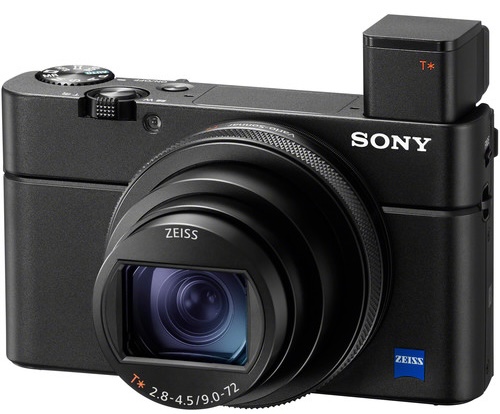 Weight: 10.7 oz.
Weight: 10.7 oz.
Megapixels: 20.1
Sensor: 1"-Type CMOS
What we like: Extremely compact for the quality you can achieve, Real Time Tracking AF; touchscreen; phenomenal lens with ZEISS glass; pop-up EVF.
What we don't: Expensive for such a small camera; bad menu layout; only 4k 30 fps video; we would like a wider aperture.
200 mm in your pocket! Clocking in at a featherlight 10.7 ounces and not much bigger than the Pixpro above, Sony's RX100 VII packs so much quality into a tiny package that it (almost) merits the absurd price tag. We found it very difficult to decide between this and the a6700 for our top award, as the RX100 series has quickly become one of the most popular cameras on the market for thru-hiking and ultralight missions. The a6700 wins out for us due to its better sensor, higher video capabilities, and interchangeable lens configuration—while only costing $100 more. But if weight is a priority over top-shelf features for you, the RX100 is downright difficult to beat. Impressive specs abound, but our standout favorites include its ZEISS f/2.8-4.5 lens with an 8.3x ultra zoom (24-200mm full-frame equivalent), 4K 30 fps video shooting with S-Log picture profiles and Active SteadyShot, a pop-up EVF, crazy fast hybrid AF with 357 phase-detect points, and a large 20.1 MP 1" CMOS Sensor. This is a powerhouse.
We spent a summer thru-hiking the Appalachian Trail with this camera, and not only captured some unbelievable images but recorded hours of quality video (in conjunction with a Sony a6300) for a trail documentary. The ability to stash it in a small fanny pack—or slim shoulder pocket—with the lens collapsed, and easily whip it out at a moment's notice gives this an edge over the a6000 series in terms of packability and ease of use. The EVF makes composing a cinch, even in harsh light, and the Real Time Tracking auto-focus is a joy to use. With an extended ISO range of 64-25,600 and an aperture of f/2.8 to 4.5, the lens—though small in size—works impressively in low-light conditions. The ZEISS glass delivers that smooth, creamy bokeh it's known for, but such a premium lens contributes to the lofty price tag—our biggest con. Other dings we have on the RX100 include its frustrating menu layout (in line with every other Sony we've used), the sheer range of AF options is overwhelming, and we wish the aperture was a bit faster. But these are small quibbles in light of its impressive capabilities, and this is just about the perfect hiking and backpacking camera—if you are willing to foot the bill.
See the Sony RX100 VII at Adorama See the Sony RX100 VII at Amazon
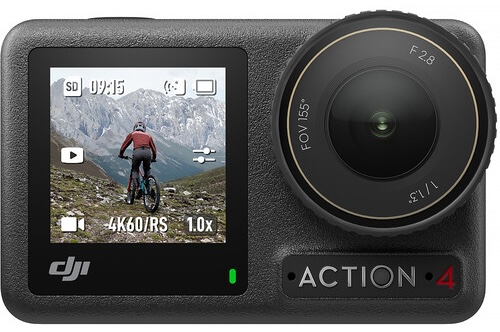 Weight: 5.1 oz.
Weight: 5.1 oz.
Megapixels: 10
Sensor: 1/1.3"-Type CMOS
What we like: Durable and waterproof; stellar video capabilities; extremely stable footage; intuitive touchscreen function; long battery life; easy to transfer footage; front and back screens.
What we don't: Not the best for photos; difficult to make adjustments when wet; more compatible with iOS devices than Android.
Action Cameras are billed for high-octane extreme sports, nail-biting motocross races, and skydiving over mountain ranges—but do they have a place in the hiking community? While their specs are certainly catered for fast-paced, dynamic movement, devices like DJI's Osmo Action 4 have found a foothold amongst trekkers for their bombproof durability, weather resistance, ease of use, battery life, and stellar video capabilities. Looking solely at the latter, very few models on this list boast 10-bit 4K video capabilities at a blistering 120 fps—and every camera that does is well north of $1,000. While this style of "GoPro" footage can be polarizing for some, it's undeniably a simple, lightweight, affordable way to capture your journey in stunning visual quality. So why didn't a GoPro snag this award? While we appreciate the abilities of the GoPro Hero 12, there are certain elements of DJI's version that we like better.
While GoPro's GP-Log and LUTs allow for flexibility in color grading, we personally prefer the look and dynamic range of DJI's D-Log M profile, and DJI's color science and smoother footage in general. Both are great cameras, but DJI's price ($100 less) and performance nudge it a smidge ahead for us. That said, the Action 4's photo capabilities are lacking compared to the Hero 12's, but are fine for what most hikers will want. Tack on a seemingly endless list of thoughtful features—including a durable waterproof construction, magnetic quick-release, over 2.5 hours of constant shooting, low-temp performance, underwater color-correction, and 360º situational stabilization—and you have one heck of a $300 power player for rugged outdoor use. We recently took the Action 4 on a climbing and backpacking road trip all over the Western U.S., using it as our primary lightweight camera for a whole slew of adventures, and came away incredibly impressed. Its burly construction and competitive specs allow you to get stellar, professional-quality footage on the most gnarly adventures you could cook up.
See the DJI Osmo Action 4 at Amazon See the DJI Osmo Action 4 at B&H
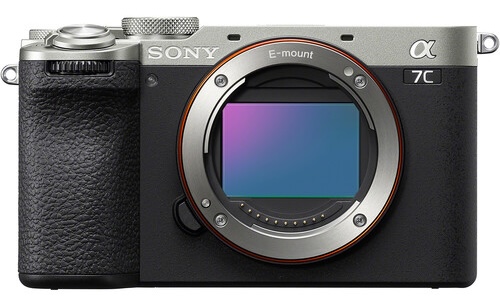 Weight: 1 lb. 2.2 oz.
Weight: 1 lb. 2.2 oz.
Megapixels: 33
Sensor: 35mm full-frame Exmor R CMOS
What we like: Full-frame function in a lightweight, compact package; durable magnesium build with dust and splash protection, relatively good value.
What we don't: Not the most competitive video capabilities; only one SD card slot; low megapixel count compared to pricier competition.
For a mere 0.8 ounces more than our top pick, the a7C packs a 35mm full-frame sensor, a top-of-the-line feature set, and a wide range of creative features into a ridiculously compact, lightweight design. Though not as specced out as its older (and more expensive) full-frame brother—Sony's mighty a7 IV—the a7C II is a fantastic alternative for lightweight travelers, hikers, and even backpackers looking to up their photo and video game with full-frame content. As one of the lightest full-frame cameras out there, we feel like its photo and video capabilities, coupled with a stalwart dust and splash-resistant magnesium construction, make it the best full-frame camera for hiking and backpacking. While you could splurge on its more expensive counterpart—the a7CR ($2,998)—the a7C II's robust feature set and relatively affordable price tag make it a solid value for the majority of trekkers. 33 MP is fine for most photographers, and its autofocus functions are widely considered to be some of the best in the game. If that doesn't cut it for you, the a7CR boasts a 61 MP sensor (and many other notable upgrades) but will cost you nearly $800 more.
For photographers, this camera is a dream come true, but videographers may be turned off by some of its stats. The a7C II can only shoot full frame 4K 10-bit footage at 30 fps, and crops in 10-bit 60 fps footage to Super 35 (APS-C crop, or 1.5x). While many—including our author—prefer shooting most video in Super 35, this could be a turnoff for others hoping for greater full-frame capabilities. The a7 IV has similar specs, but the a6700 above shoots 4K up to 120 fps (albeit in a cropped sensor)—a wildly impressive feature. For most users working on personal projects, however, the a7C II will be just fine. An extended ISO sensitivity range of 50-204,800 for photos (50-102,400 for video) allows for stellar low-light shooting, blowing top picks like the a6700 out of the water. We also appreciate the ability to shoot in Sony's buttery S-Cinetone (along with many others) picture profile. All told, the a7C II is a lightweight full-frame powerhouse at a relatively affordable price point. While you could tote the a7CR at the same weight, it's probably too expensive for most backpackers, and its younger sibling will get the job done with less damage to your wallet.
See the Sony a7C II See the Sony a7CR
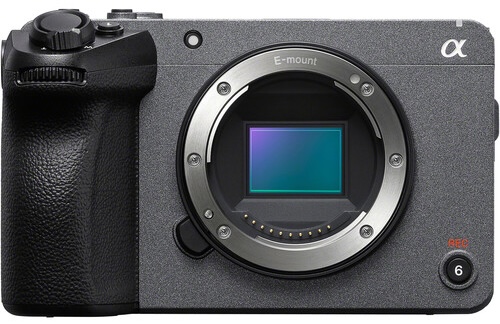 Weight: 1 lb. 6.8 oz.
Weight: 1 lb. 6.8 oz.
Megapixels: 26.1
Sensor: APS-C BSI CMOS
What we like: Stellar video-specific feature set for professional filmmakers; lightweight, compact design; affordable for a cinema camera; great in low light; weather-sealed.
What we don't: Photo capabilities are lacking; on the heavy/bulky side for APS-C; no built-in NDs; LOG profile isn't our favorite compared to other brands; crop-sensor isn't for everyone; no EVF.
Thinking of crafting a full-fledged documentary of your journey? Or maybe you just love the creative process of curating high-quality clips of your trek. Whatever your mission, it's near impossible to find a more worthy, lightweight cinema camera for the trail than Sony's groundbreaking FX30. While it can't hold a candle to traditional cinema models like Canon's EOS C70 or Sony's FX6, who has the desire—or strength—to lug something that clunky on a backpacking trip? Sony borrowed a slew of specs and color science from its advanced cinema cameras (including its VENICE line), threw a massive list of video-specific features in the mix, and hit it all with a shrink ray gun to create the streamlined FX30. To be sure, it lacks a handful of coveted features higher-end models possess—such as built-in ND filters, full-frame capabilities, and robust dial layouts—but performs impressively given its size and weight. It has the necessary chops for everything but the most high-end productions. And, if you need more pro features, we've also hiked hundreds of miles with the fancier FX3 ($3,900)—though we wouldn't recommend it.
As expected from a cinema camera, the FX30 shoots 10-bit UHD 4K video up to 120 fps, and 1080p up to 240 fps. In terms of professional picture control, it features Sony's cherished S-Cinetone profile, along with other popular profiles such as S-Log3 (which allows you 14+ stops of dynamic range) and HLG. It also has the ability to store up to 16 user-created LUTs and three presets for accurately monitoring footage. That said, a handful of cons have surfaced during our time with the FX lineup. Most notably, the lack of an electric viewfinder makes composing in harsh light (as is common on the trail) difficult. We also aren't huge fans of its photo capabilities when compared to other models on this list—but that wouldn't be the main concern of hikers looking for a cinema model. For those needing a versatile, quiver-of-one camera for photo and video, we would direct you elsewhere. However, if you primarily aim to shoot professional video—and only need photos for occasionally sharing on socials or sending to friends—the FX30 is downright difficult to ding.
See the Sony FX30 at Amazon See the Sony FX30 at B&H
 Weight: 14.4 oz.
Weight: 14.4 oz.
Megapixels: 24.2
Sensor: 35mm full-frame CMOS
What we like: Incredible performance-to-weight ratio; compact size; fantastic video specs; great colors; impressively steady shot.
What we don't: Pricey; not as high resolution as other full-frame models; not the best in-hand feel; no EVF, headphone jack, or hot shoe
A full-frame camera that fits in your hipbelt pocket? Panasonic’s Lumix S9 is about as close as it gets. Weighing just over 14 ounces and boasting a 24.2 MP full-frame CMOS sensor, this tiny powerhouse is an absolute gem for hikers and backpackers who want pro-level imagery without the bulk. It’s one of the smallest full-frame mirrorless cameras we've gotten our hands on, but don’t let the size fool you—this thing packs a serious punch. We recently took this ultralight wonder on a stint along the Appalachian Trail in Georgia, and came away with stellar results and attractive content. A true headliner for us is the video performance: You get 6K at 30p and 4K at 60p 10-bit recording, 5-axis sensor-shift stabilization for impressively smooth handheld shots, and a fully articulating LCD touchscreen for dialing in your frame. We also love Panasonic’s Real-Time LUT feature, which lets you apply custom or signature color presets directly in-camera—a dream for content creators wanting a fast turnaround for social media. All told, this is one of the most exciting ultralight options we've seen for serious photo/video work in the backcountry. The retro vibe packaged in a plethora of color options is also a fun touch—our red model is one of our favorite cameras to tote around town for street photography.
That said, the S9 is not without its quirks. To achieve such a light, compact design, some noticeable sacrifices were made. The lack of an electronic viewfinder, headphone jack, and hot shoe may be deal-breakers for some. Also, the rear screen—while nice for vlogging—can be hard to read in bright sunlight, which is pretty much a given on most backpacking trips. It’s also not as high-res as other full-frame competitors (the a7C II above boasts a 33 MP full-frame sensor), and the in-hand feel is a bit clunky due to the minimalist grip. We also weren't incredibly impressed with its autofocus tracking, and it has mediocre rolling shutter performance. But if you're willing to work around those limitations, the Lumix S9 delivers an exceptional performance-to-weight ratio and best-in-class video specs for such a small and streamlined setup. For creators who live on the move—and aren’t willing to lug a DSLR up a trail—this is one of the most compelling releases on the market.
See the Panasonic Lumix S9
 Weight: 9.7 oz.
Weight: 9.7 oz.
Megapixels: 20.3
Sensor: 1/2.3"-Type CMOS
What we like: Affordable; lightweight; great image colors; insane 40x zoom range.
What we don't: Not our favorite aperture range; not the best ISO sensitivity; no touchscreen or EVF; can't shoot in raw; image quality decreases at longer focal lengths.
A brief glance at our award list above should portray an obvious theme: We're suckers for Sony cameras on trail. In many respects, we think their versatility and performance outshine other manufacturers for outdoor purposes, but that's not to say the other power players shouldn't be considered. Canon is a wildly popular brand for hikers and backpackers, and many of our author's hiking friends film and photograph their adventures through Canon glass. Their PowerShot SX740 HS falls on the budget end of their PowerShot family, with the PowerShot G7 X Mark III ($800 MSRP) serving as the higher-ticket performance pick of their point-and-shoot family (temporarily out of stock at the time of publishing). The headliner here is SX740's zoom capabilities. With a staggering 40x zoom range (the 35mm equivalent of 24-960mm), it blows the focal range of every other point-and-shoot we've tried out of the water. Accompanying the zoom is 5-axis optical image stabilization, which does an adequate job of keeping shots sharp when shooting at long focal lengths.
Despite the stabilization and relatively high megapixel count, image quality is noticeably fuzzier at the telephoto fringe of the spectrum—which is to be expected from a lens so physically small. Don't look at this spec and assume you'll be able to capture images akin to something from a true telephoto lens. But, it's a fun feature to have for roughly capturing far-off wildlife or distant landscapes mid-trek. Compounding the issue, its limited ISO sensitivity (extended: 100-3,200), slow-ish aperture of f/3.3 to 6.9, and lack of raw shooting translates to less versatility in low light settings and high focal lengths. Upgrading to the popular G7 X Mark III will amend some of these woes—with much better ISO sensitivity and a faster aperture of f/1.8 to 2.8 (albeit with a lower zoom range of 24-100mm). The video capabilities of the SX740 aren't anything to write home about, but they will get the job done with 4K shooting up to 30 fps and 1080p up to 60 fps. All told, this compact point-and-shoot produces fantastic photos at wider focal lengths, delivers incredible zoom, and is a versatile model for capturing stellar footage with a minimal weight penalty.
See the Canon PowerShot SX740 HS at Amazon See the Canon PowerShot SX740 HS at Walmart
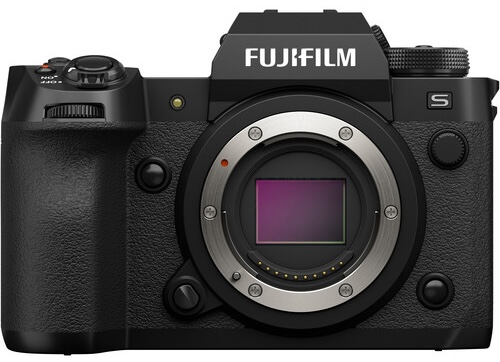 Weight: 1 lb. 8 oz.
Weight: 1 lb. 8 oz.
Megapixels: 26.2
Sensor: 23.5 x 15.6 mm (APS-C) CMOS
What we like: Great colors in JPEG and raw, super fast shooting; fantastic video performance, robust weather-sealing; effective autofocus; solid hybrid video/photo camera.
What we don't: Heavy and bulky; not the best low light performance; expensive for an APS-C; touchscreen can be finicky.
Now here is a power-player in the crop sensor realm. Fujifilm has been a long-time favorite in the photography crowd, but models like the X-H2S bring pro-level video capabilities to an already stellar camera design. Though the X-H2S tips the scales at 1 lb. 8 oz. (the heaviest on our list), the sheer amount of tech and pro features crammed under the hood might make the weight penalty worth it for the right adventurer. We recently used the X-H2S to film a backpacking and mountaineering expedition in Nepal, in conjunction with a Sony FX3. Trekking over 80 miles and climbing a 6,000-meter peak, we thoroughly put it through its paces and came away incredibly impressed. Though it doesn't mesh well with an ultralight kit, it holds its own in the elements (even at altitude) and punches well above its weight from a performance perspective. Billed for fast-paced action shots, it can shoot stills at up to 40 fps and capture full-sensor 10-bit 6.2K (up to 30 fps) or 4K (up to 120 fps) video. Some of the most impressive video and photo capabilities on this list.
We love this camera's wide array of color profiles for both photo and video and found ourselves using its popular Eterna Film Simulator the most. This provides a flat, low-saturation image that offers solid flexibility for post color grading. Its AI subject detection autofocus is quick and reliable, and the sensor’s rapid 120 fps readout speed allows it to take autofocus readings frequently for impeccable accuracy. So what's the catch? As one of the most specced-out APS-C models on the market, the $2,500 price tag puts it out of reach for many backpackers and seems steep for a crop sensor camera. Additionally, it's heavier than much of the competition and has a bulkier silhouette, making it sub-optimal for lightweight backpacking. Our other ding has to do with its mediocre low-light performance, with an extended ISO sensitivity of only 80-51,200 for photos, and 160-25,600 for video. Finally, the touchscreen can sometimes be finicky. That said, if you have the dough, this is hands down one of the highest-performing APS-C cameras on the market and produces some of the finest footage we've seen on trail.
See the Fuji X-H2S at Amazon See the Fuji X-H2S at Adorama
 Weight: 11.4 oz.
Weight: 11.4 oz.
Megapixels: 24.2
Sensor: APS-C CMOS
What we like: Stellar video chops; light and compact; great autofocus and subject tracking; smooth ergonomics; vertical orientation mounting point; affordable.
What we don't: 4K 60 video crops in significantly; not the best digital stabilization; not the best rolling shutter performance; not our favorite button layout, no EVF.
Now here's a fun little powerhouse. While the Canon SX740 HS above is undeniably attractive at a mere 9.7 ounces, it leaves much to be desired for the serious photographer/videographer hoping to document their trek with an interchangeable lens body. At a scant 11.4 ounces (body only) with a smooth, compact silhouette, the EOS R50 V promises to rival our other favorite APS-C cameras as one of the best crop-sensor cameras for hiking and backpacking. We're sure it'll inch its way higher up in rankings on this guide once we clock some more miles with it, as it's lighter and more affordable than top-tier models like Sony’s a6700, but still brings a serious feature set to the table. The 24.2 MP APS-C sensor is backed by Canon’s DIGIC X image processor and delivers 4K video up to 60p (cropped) and 30p (full width), with a suite of creative video tools like Slow and Fast mode, Canon Log 3, False Color, and more. Autofocus is a major strong point too, with Canon’s excellent Dual Pixel CMOS AF II system offering subject tracking for people, animals, and vehicles. We've been seriously impressed by how smoothly this operates. Throw in intuitive, creator-friendly features like a front-facing record button, vertical video tripod mount, and color filters, and you’ve got a smart, streamlined tool for ultralight hikers, vloggers, and beginner filmmakers alike.
Still, there are a few compromises that come with the lightweight build and budget-friendly price. While you do get 4K 60p video, it’s cropped heavily, which limits its usefulness. We also found the digital image stabilization a bit lackluster compared to some competitors, and the rolling shutter can struggle during fast pans or handheld footage (especially in 4K 24p or 30p). Ergonomically, we honestly love how the camera fits in our hands (which is hard for us to admit as die-hard Sony lovers), but the button layout just isn’t our favorite. We wish there were two control dials instead of one at the top of the camera, with the ability to tweak shutter speed or aperture with your pointer finger. Instead, you have to manage both dials with your thumb, slowing things down when trying to nail that perfect exposure (often a time-sensitive process on fast-paced treks). The main dial layout also took a bit of getting used to (though, again, we've been indoctrinated by the Sony camp). This, coupled with the lack of an EVF (a clear pro to the a6700), makes the EOS R50 V better suited for occasional photo work rather than serious stills shooting. It takes fine images, but if you’re looking for a model that excels at both photo and video, we'd direct you to a more traditional hybrid model with fewer vlogging-focused trade-offs. But if you can work around these limitations, especially if video is your main objective, the R50 V is an impressively complete camera for trail photographers and videographers who want big-time capability in a compact, user-friendly body, without breaking the bank or their back.
See the Canon EOS R50 V
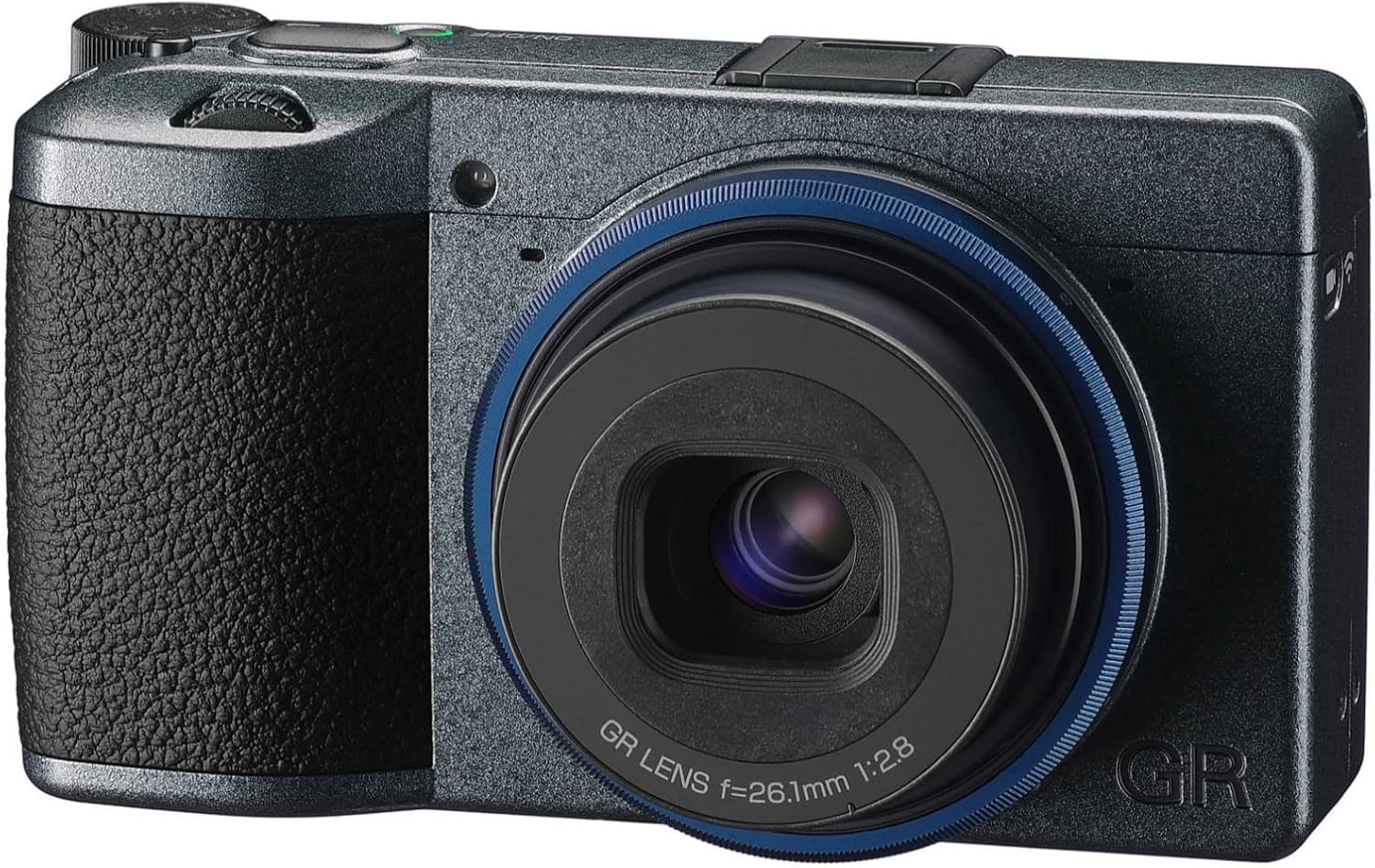 Weight: 9.2 oz.
Weight: 9.2 oz.
Megapixels: 24.2
Sensor: APS-C CMOS
What we like: Impressive ISO sensitivity and sensor for its size; gorgeous colors and picture profiles; built-in ND filter on the GR IIIx (two stop ND 0.6); great manual settings; touchscreen LCD screen; broad aperture range; razor-sharp lens.
What we don't: Expensive; in high demand so stock is inconsistent; lackluster video capabilities; poor battery life; no EVF; no weather protection; not the most durable.
If pro-level photos from the absolute smallest camera possible are what you seek, look no further. There's a reason Ricoh's GR IIIs are flying off the shelves, and it's not because of a modest price tag. It's costly, but if you have the cash, we are hard-pressed to drum up any competition that generates such intriguing, professional-looking pics. The natural comparison would be to Sony's RX100 VII above. Though we give the edge to Sony for its versatility and video capabilities, Ricoh takes the cake for still image performance (and it's over an ounce lighter). It boasts a better sensor, creamier images, and a slew of fun picture profiles, including several that give the image a natural filmic flair. Loop in the "HDF" version's highlight diffusion filter (limited stock), and you can churn out some seriously dreamy photos (the GR IIIx includes a built-in ND filter). We recently got to play with the Ricoh on a couple of climbing and hiking adventures around Colorado, and were blown away by its impressive ISO sensitivity (100-102,400), beautiful color science, and razor-sharp 26.1mm f/2.8 (40mm full-frame equivalent) lens.
Easily sliding into your pants or hipbelt pocket, the GR IIIx disappears in your kit and weighs next to nothing. So why slot it so low on our list? As one of the smallest cameras among its large sensor peers, it is an extremely coveted gadget for on-the-go photojournalists, international travelers, and of course, ultralight hikers and backpackers. This means it is often out of stock—perhaps our biggest con (there are often renewed, discounted versions of the GR IIIx available on Amazon). The slim silhouette has other notable downsides, with a basic button layout and no EVF being the most obvious. Several other features were sacrificed in creating such a small beast, including no weather protection, short battery life, a fixed LCD screen, and poor video chops. It taps out at 1080p 60 fps, which is barely enough to be considered competitive in today's market and is disappointing given the price. However, if you use it solely for photos—and can look past our other gripes—this is a prime contender for the best point-and-shoot award. It's about as good as it gets for serious photographers trying to maintain an ultralight backpacking loadout on trail.
See the Ricoh GR III HDF
 Weight: 1 lb. 1.5 oz.
Weight: 1 lb. 1.5 oz.
Megapixels: 20.9
Sensor: DX-Format CMOS
What we like: Affordable but with solid performance; compact construction; great ergonomics; stellar extended ISO sensitivity; crisp raw images; improved video specs than last gen.
What we don't: Most native Z mount lenses are pretty big; bulkier than others on this list; only one UHS-1 card slot, latest gen heavier by about 4 oz.
We'd be remiss not to include a Nikon model in the fold, as the brand certainly has some stellar choices for the backcountry traveler. While they aren't our personal favorite for hiking and backpacking, fans of Nikon's glass and color science have plenty of options for light missions on trail, and Nikon's robust range of DSLRs, mirrorless models, and point-and-shoots means there's something for everyone. Their mirrorless APS-C Z50II strikes a healthy balance of weight, performance, and value for us from their lineup. Clocking in under a grand, this is one of the cheaper mirrorless cameras on our list, but it doesn't skimp on impressive specs and durability. While it doesn't have the same photo prowess as some other APS-C mirrorless models—most notably the 26.2 MP Fujifilm X-H2S—it boasts impressive extended ISO sensitivity (100 to 204,800 for photo, 100 to 25,600 for video), great image quality, quick autofocus and tracking performance, weather sealing, and impressive video capabilities. The latest upgrade bumped video resolution to a max of 10-bit, 60 fps at 4K (and it can shoot 120 fps at 1080p for the occasional slow-motion composition). Pretty impressive at this price point.
Nikon's menu layout is much more intuitive than our Sony daily drivers, making this more approachable for beginners. This simplicity goes hand-in-hand with less performance, however, and serious creatives will probably be left wishing for more pro-level specs. The lack of multiple UHS-1 card slots limits storage and performance, and it shoots stills at a max of 30 fps (slower than some of the competition, but a pump up from the 11 fps of the previous generation). We recently brought this on a product photoshoot in Tennessee, and came away less-than-impressed by its autofocus and resolution. While editing the pictures, we felt like the images came across better exposed and crisper in the image preview in-camera. This isn't something we have experienced with other Nikon models we've tested, such as the Nikon Zf and Zfc. This could easily be chalked up to user error, however, and we need some more time with this camera to really dial in the best settings. The Z50II also eschews internal image stabilization—a coveted feature for serious filmmakers and photographers—relying instead on lens-based stabilization. These qualms aside, if paired with a fast, lightweight lens, we still think this is a stellar pick for lightweight hikers looking for middle-of-the-road performance in a streamlined, affordable package.
See the Nikon Z50II at B&H
| Camera | Price | Weight | MP | Sensor | Category |
|---|---|---|---|---|---|
| Sony a6700 | $1,398 | 1 lb. 1.4 oz. | 26 | APS-C BSI CMOS | Mirrorless APS-C |
| Kodak Pixpro FZ55 | $150 | 3.7 oz. | 16 | 1/2.3"-Type CMOS | Point-and-Shoot |
| OM SYSTEM Tough TG-7 | $550 | 8.8 oz. | 12 | 1/2.3"-Type CMOS | Point-and-Shoot |
| Sony RX100 VII | $1,698 | 10.7 oz. | 20.1 | 1"-Type CMOS | Point-and-Shoot |
| DJI Osmo Action 4 | $299 | 5.1 oz. | 10 | 1/1.3"-Type CMOS | Action Camera |
| Sony a7C II | $2,200 | 1 lb. 2.2 oz. | 33 | Exmor R CMOS | Mirrorless Full-Frame |
| Sony FX30 | $1,800 | 1 lb. 6.8 oz. | 26.1 | APS-C BSI CMOS | Mirrorless APS-C |
| Panasonic Lumix S9 | $1,498 | 14.4 oz. | 24.2 | 35mm CMOS | Mirrorless Full-Frame |
| Canon PowerShot SX740 HS | $530 | 9.7 oz. | 20.3 | 1/2.3"-Type CMOS | Point-and-Shoot |
| Fujifilm X-H2S | $2,500 | 1 lb. 8 oz. | 26.2 | APS-C CMOS | Mirrorless APS-C |
| Canon EOS R50 V | $699 | 11.4 oz. | 24.2 | APS-C CMOS | Mirrorless APS-C |
| Ricoh GR III HDF | $1,150 | 9.2 oz. | 24.2 | APS-C CMOS | Point-and-Shoot |
| Nikon Z50II | $907 | 1 lb. 1.5 oz. | 20.9 | DX-Format CMOS | Mirrorless APS-C |
We all love to share our stories, but sometimes adequately portraying them through a lens can feel downright impossible in the backcountry. In an effort to creatively convey our adventures with quality packable cameras, the Switchback Travel team has tinkered with just about every slimmed-down model on the market. We're extremely particular about what we allow in our packs, and carefully consider any glass we stow in our kit before hitting the trail. Senior Editor Chris Carter curated this list and is an avid long-distance backpacker and ultralight traveler. He has spent enough time faffing with chunky DSLRs mid-trip to know the importance of a streamlined, lightweight camera for efficiently capturing stories on the go. A seasoned thru-hiker, Chris has completed the Triple Crown of long trails in the United States (AT, PCT, and CDT), and continues to backpack and explore around the world—creating short films of most treks he embarks on.
Drawing from years of documentary work, commercial gigs for outdoor brands, and stints as a freelancer and PBS cameraman, Chris pulled from a diverse film and photography resume to build this round-up. His cameras are unwittingly toted to some rowdy locations, and their durability, weather resistance, and overall performance are truly put to the test. In reviewing each camera, we focus on several key factors before giving any device real estate above. Weight-to-functionality ratio, photo performance, video capabilities, battery life, and professional feature sets are among the top considerations. Finally, we know that the competition for the lightweight camera podium is fierce and constantly evolving—more so than many categories. For that reason, we keep our finger on the pulse of new products as they surface, adding standouts to our list along the way and ensuring our existing reviews stay up-to-date with accurate specs and info.
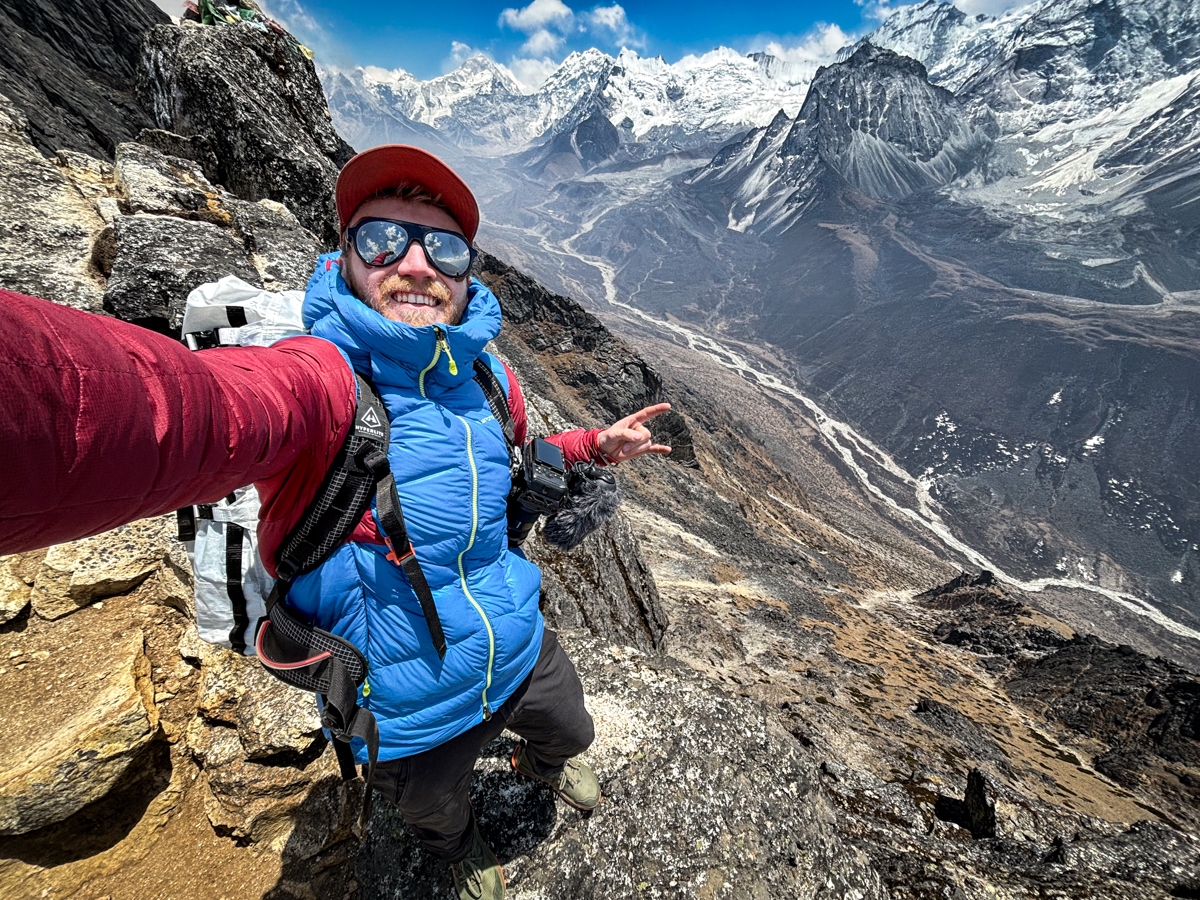
The list above represents a broad range of types and quality of cameras, so it's important to consider the full range of specs before jumping to a decision. Though an interchangeable lens camera body may have a comparable weight to a point-and-shoot, you'll have to consider the weight of the lens you select, which could add anything from a few ounces to several pounds on your rig (more on this in "ideal focal lengths"). Below, we break down key elements of each category, and who they may be best suited for.

Point-and-Shoot
Smartphone cameras have become so mainstream and high-quality that it may be hard to imagine a time when you couldn't just snap a pic of anything you wanted at any moment. Those old Nokia bricks just didn't cut it. During this time, credit-card-sized point-and-shoots rose to popularity, allowing people to stash a light, compact camera—often with zoom and video capabilities—in their pockets or purse for those just-in-case photo ops. Fast-forward to today, where the ubiquitous iPhone sports a camera that dwarfs any point-and-shoot we carried back in the day.
At the higher end of the spectrum, the iPhone 16 Pro has a main camera touting a shocking 48 MP sensor and a brilliant interface that allows you to tweak camera settings, make edits, and easily share your content across all platforms on the go. In light of such capabilities, are point-and-shoots obsolete in our current digital age? We'd argue they aren't—especially for hiking and backpacking.
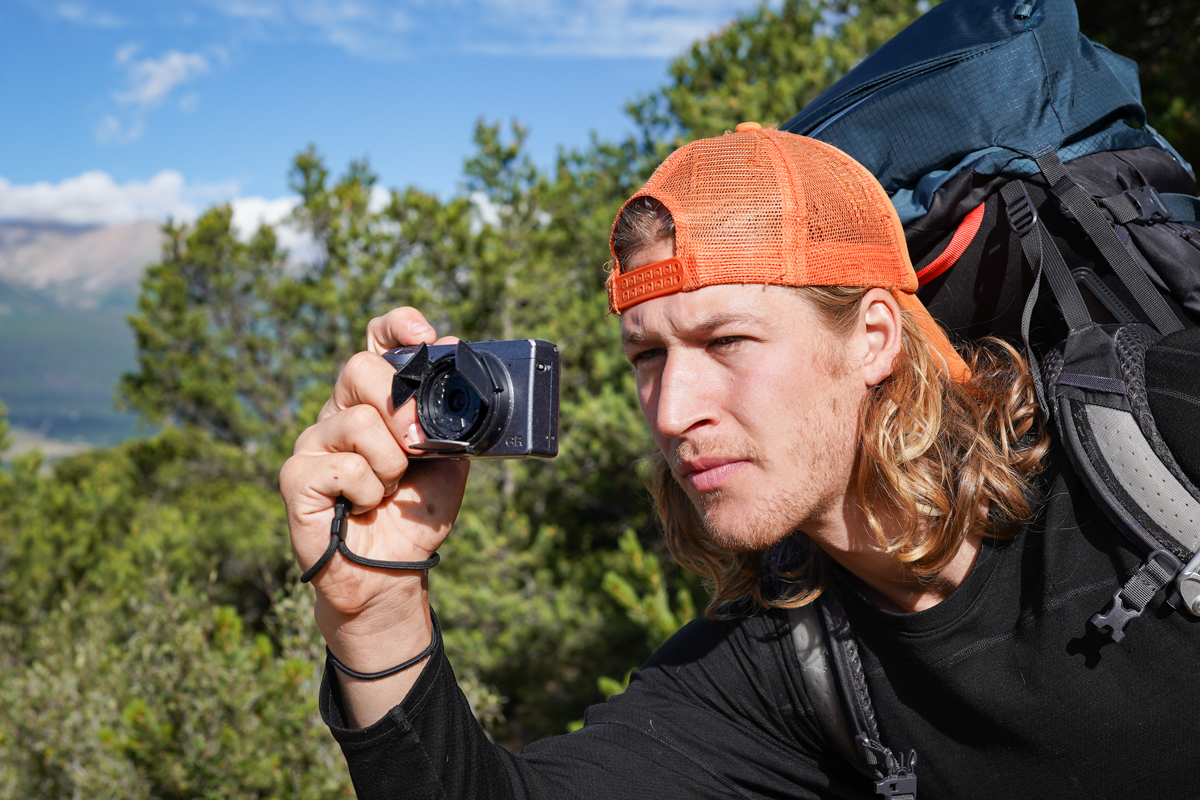
While it's true that smartphone cameras afford a quality of image that many point-and-shoots fall short of, there is no substitute for a true physical lens for capturing a natural-looking image and shallow depth of field. Photos from a point-and-shoot (particularly higher-end models) have a clean, smooth look that a smartphone just can't achieve. Here's a hot take: iPhones have become so mainstream that their photos are immediately recognizable and appear flat, generic, and just generally boring—turning even blossoming photo critics away. They get the job done, but hold little intrigue for us compared to what you can capture with a dedicated camera. Additionally, having a device reserved solely for photos or videos on a backpacking trip allows you to conserve precious battery life on your phone for navigating the backcountry or signaling for help in case of an emergency. Our thru-hiking friends whose phone is their only camera are constantly struggling to keep their phones from dying between town stops.
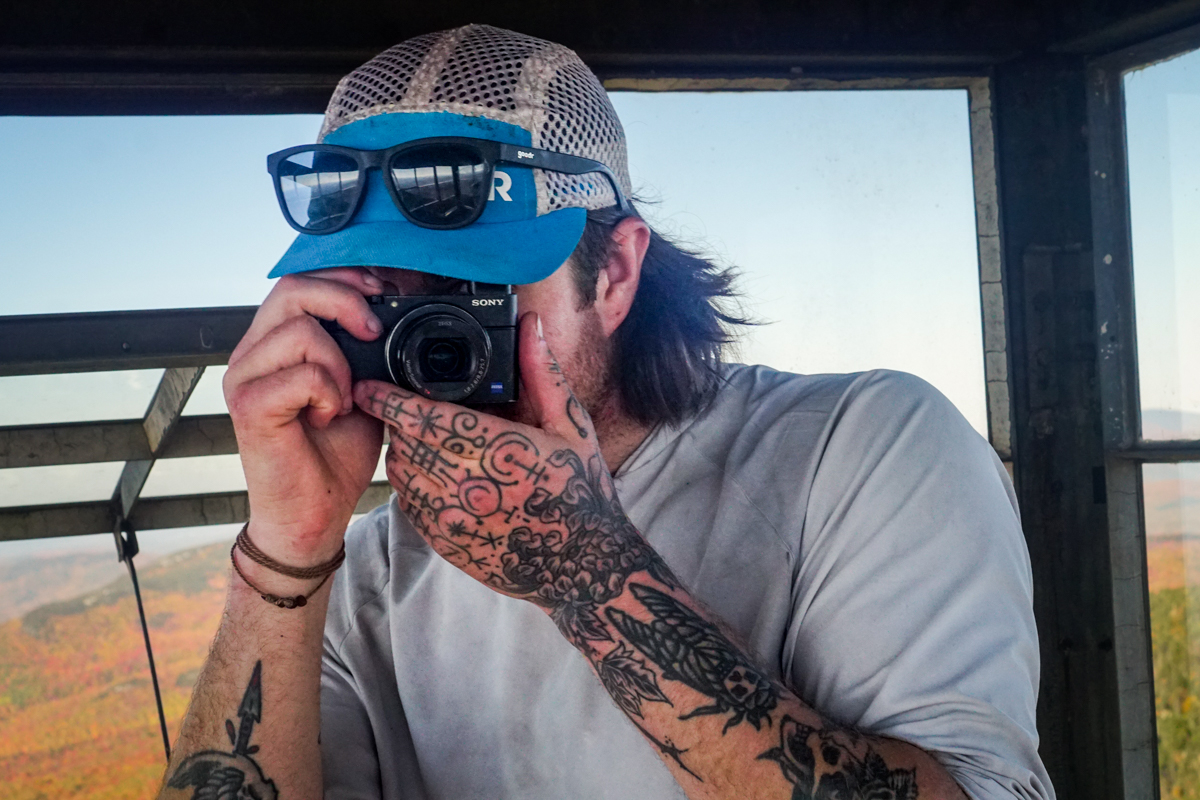
For us, all it takes is a vibrant shot from something like Sony's RX100 VII to remind us that the weight penalty is worth it. The creamy colors, smooth bokeh, and overall feel of these images blow smartphone pics out of the water. Plus, if you plan to shoot a significant amount of video on your trek, most higher-end point-and-shoots boast incredible filmmaking features, with generous ISO sensitivity for various lighting situations, fast apertures, and an array of flat color profiles for color grading freedom in post-production. For the budget-conscious hiker, something like Kodak's Pixpro FZ55 will give you passably crisp images—that we still like better than an iPhone's—for a mere $150. We've also shot many rugged trips on Nikon's old "tough" waterproof COOLPIX AW100 ($259). On the other end of the spectrum, Ricoh's GR III HDF ($1,150) churns out unbelievably professional images for a sub-10-ounce device at a much higher price point. Go with a point-and-shoot if minimal weight and a small pack size are primary concerns over top-shelf image quality and pro-level specs.
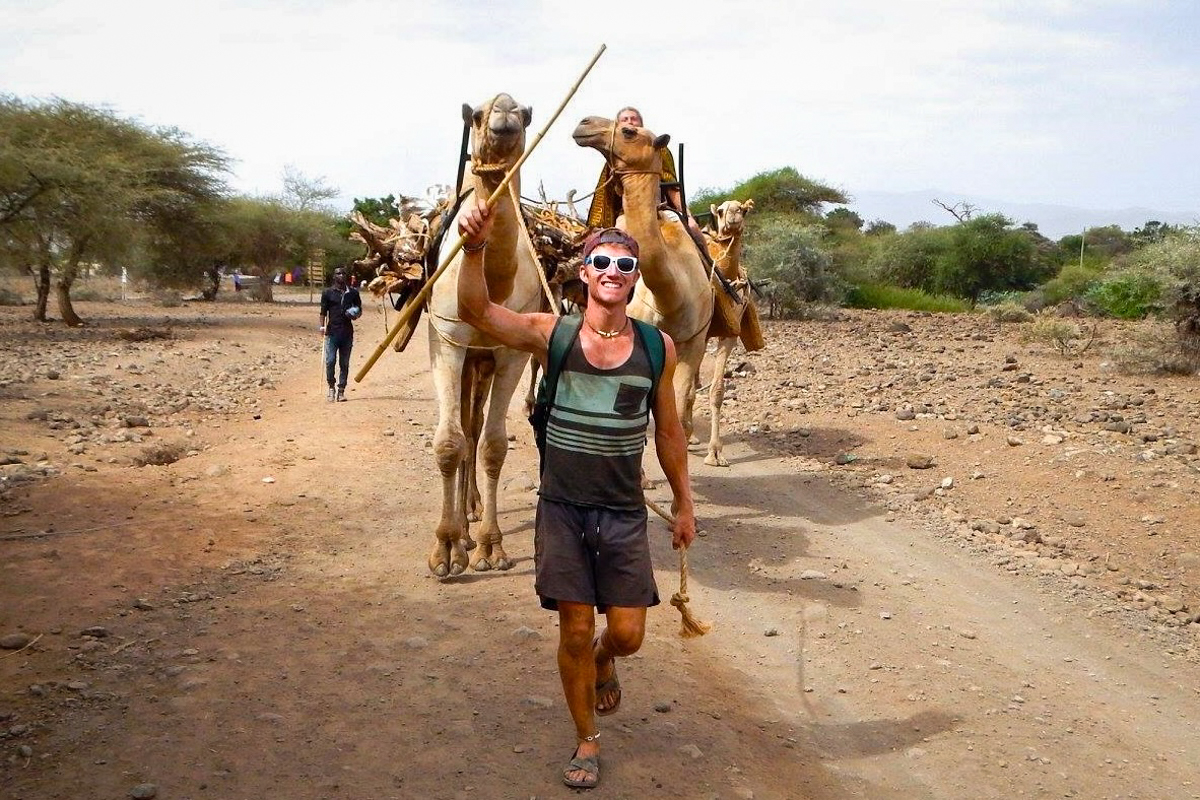
Mirrorless
Mirrorless cameras offer DSLR-like image sensors in compact bodies—they are larger than point-and-shoots but smaller than DSLRs. Their sensor technology allows manufacturers to craft compact, streamlined bodies in both crop sensor APS-C and full-frame configurations. Mirrorless sensors have removed all of the mirror design components—traditional pentaprisms and reflex mirrors—instead using an electronic imaging sensor to ensure the image shown to the photographer through the viewfinder is identical to what is taken by the camera. This is by far our favorite category for hiking and backpacking, due to their balance of weight, size, video performance, and overall function.
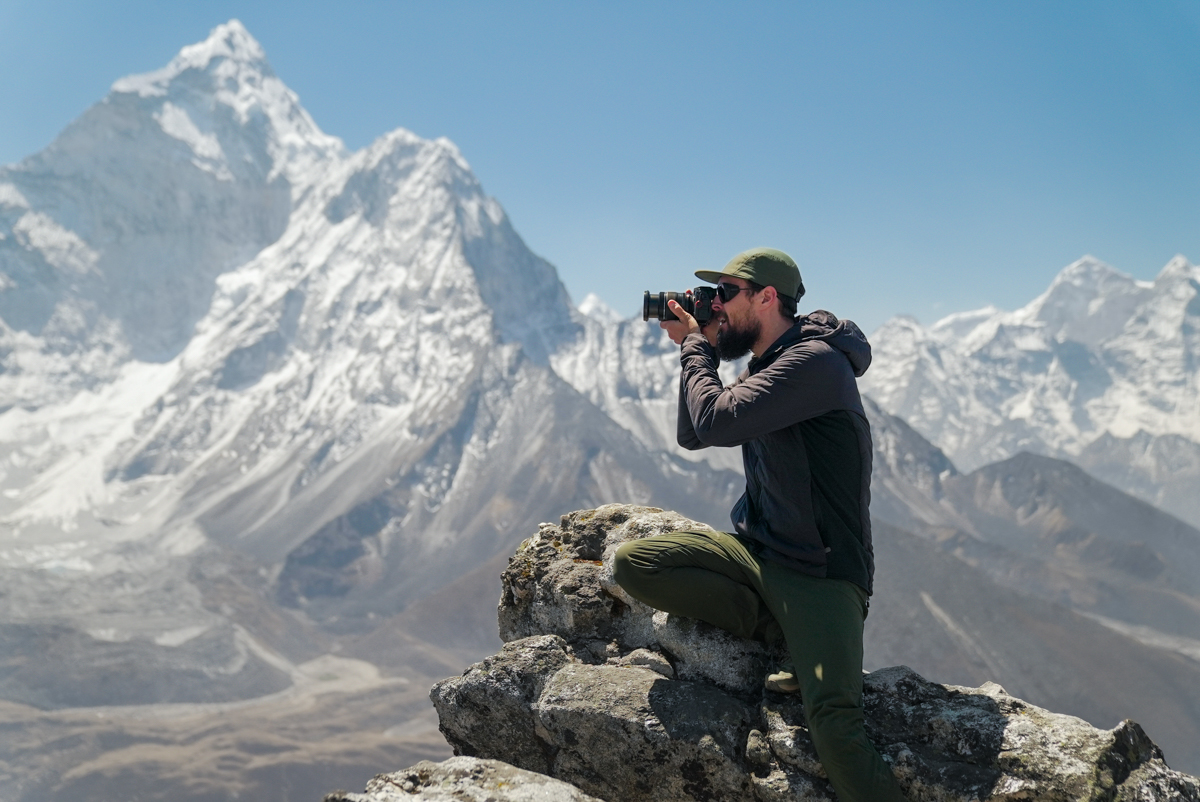
Mirrorless cameras are perfect for hikers who want professional-grade photos without the bulk. Many professional landscape photographers we know have even made the switch to mirrorless due to the smaller size and lower weight, but keep in mind that the cost of these cameras is similar to a DSLR, if not higher. Mirrorless models do tend to have worse battery life than DSLRs, since they have to power both the screen and sensor at all times. This means you'll have to carry several batteries for long backpacking trips, or a higher-capacity battery bank, which all add weight and bulk to your kit. While we are loyal to our Sony cameras, they tend to demand more juice than other brands we're testing.

Our absolute favorite mirrorless camera for hiking and backpacking is the sleek and lightweight Sony a6700. It's heavier than a point-and-shoot but boasts incredible photo and video capabilities. We've also recently been incredibly impressed with the Canon EOS R50 V. This design kind of came out of left feild for us, but we've been grabbing it for loads of ultralight backpacking trips recenlty, primarily when shooting video is our main concern. We still prefer Sony's color science and video capabilities over this new Canon offering, but it ducks under the a6700's weight by several ounces, and is very streamlined for easily shooting impressive, high-res video on the go. For a bump in feature set and performance, Fujifilm's popular X-H2S is a pricier and heavier pick but packs a serious performance punch in a streamlined silhouette.
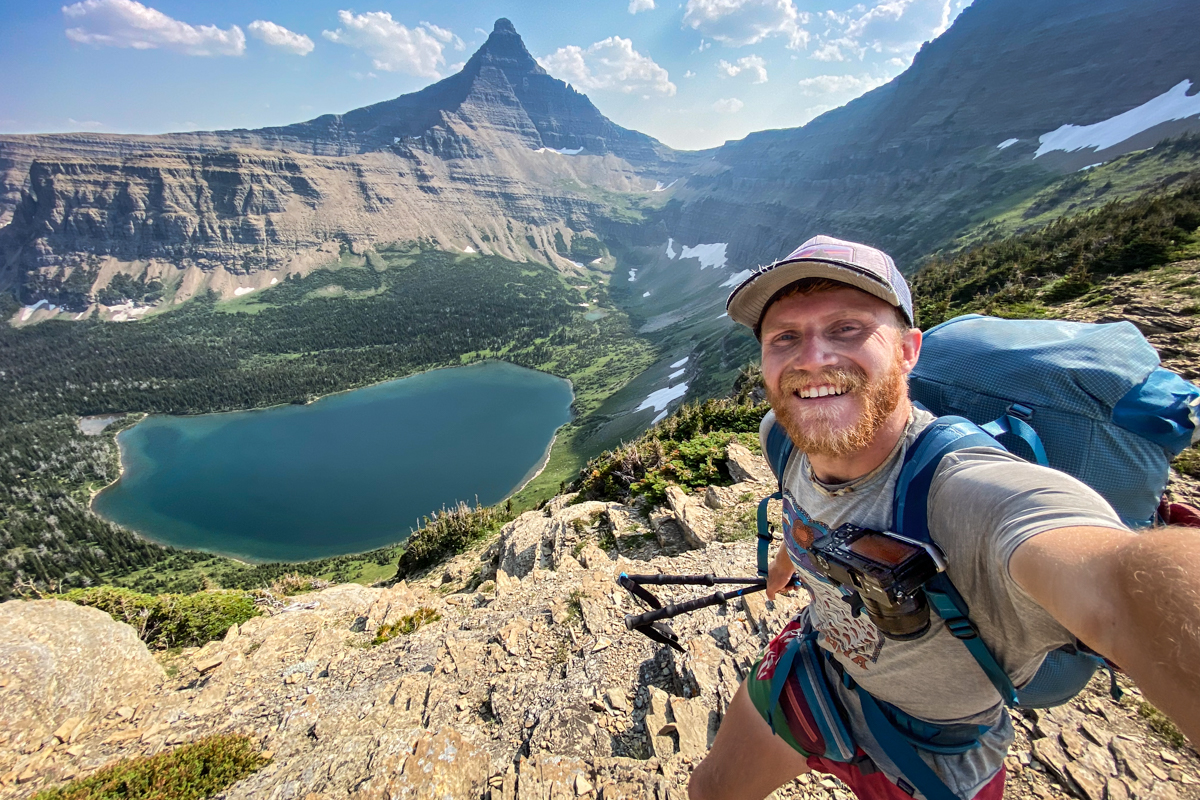
DSLR
Digital Single Lens Reflex cameras (DSLRs) are the heaviest of all digital cameras, but they also have the best components and the widest selection of lenses. These cameras function by light hitting a mirror angled at 45 degrees, which then goes straight up into an optical viewfinder, showing an exact picture of what the lens is looking at. When you take a photograph, that mirror pops out of the way to reveal the image sensor. Since they require a big internal mirror, DSLRs are heavier and clunkier than mirrorless models. That said, the lack of a digital processing "middleman" means these cameras are simpler and easier to troubleshoot than their complex mirrorless counterparts—which is an undeniable plus.

For hiking, the lightest crop sensor DSLRs can clock in under 13 ounces for the camera body (but aren't the most performative), while full-frame high-ticket options like the popular Canon EOS 6D Mark II or Nikon D850 both weigh around 2 pounds. You are definitely making a sacrifice in choosing a DSLR for hiking in terms of weight and bulk, but it may be worth it for the image quality and use off the trail. We didn't include any on our round-up because the sacrifice just isn't worth it for us while hiking—and the mirrorless market has come so far—but serious traditional photographers who don't shoot much video may prefer to tote one into the backcountry.
Action Cameras
Action Cameras, such as DJI's Osmo Action 4 and GoPro's Hero 12, have some of the lightest, weather-proof builds of any camera for hiking, but have polarizing performance. Some enjoy that classic wide and stable "GoPro" vibe for videos and photos, but based on our research, most hikers aren't too flattered by the flat, generic images you get from these devices (similar to content from iPhones). Where action cameras shine, however, is in fast-paced technical situations like peak bagging, mountaineering, or fast-packing, where it would be too awkward to haul a bigger camera.
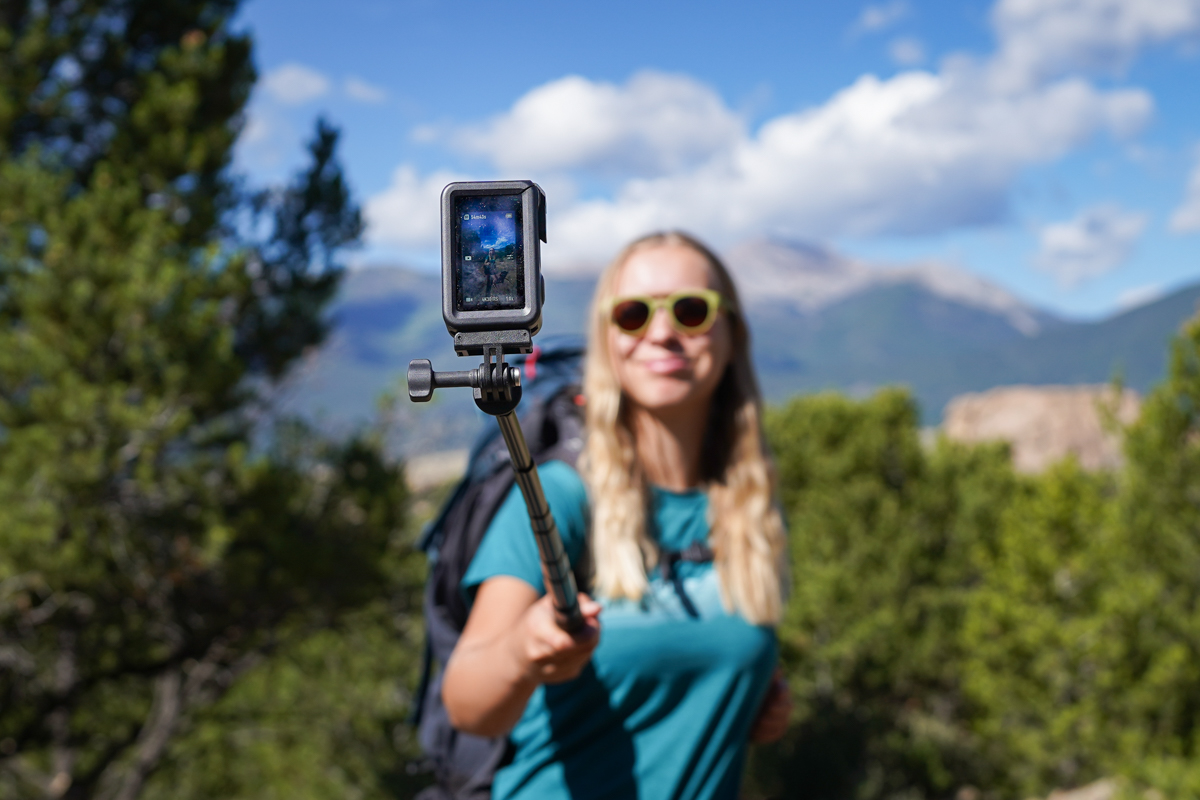
The POV shots you can get with these cameras are unprecedented, and they fend off much more torture than most traditional cameras. They also usually boast impressive video capabilities. But you do sacrifice a lot with such a streamlined setup. While models like DJI's Action 4 have some digital zoom, your focal length and manual control are limited, and navigating the small LCD screens can be frustrating. Serious photographers will quickly be left wanting more. We recommend using action cams for the occasional wide shot on your trip, supplemental B-roll footage if filming, or if you're facing constant heinous weather on your trek.
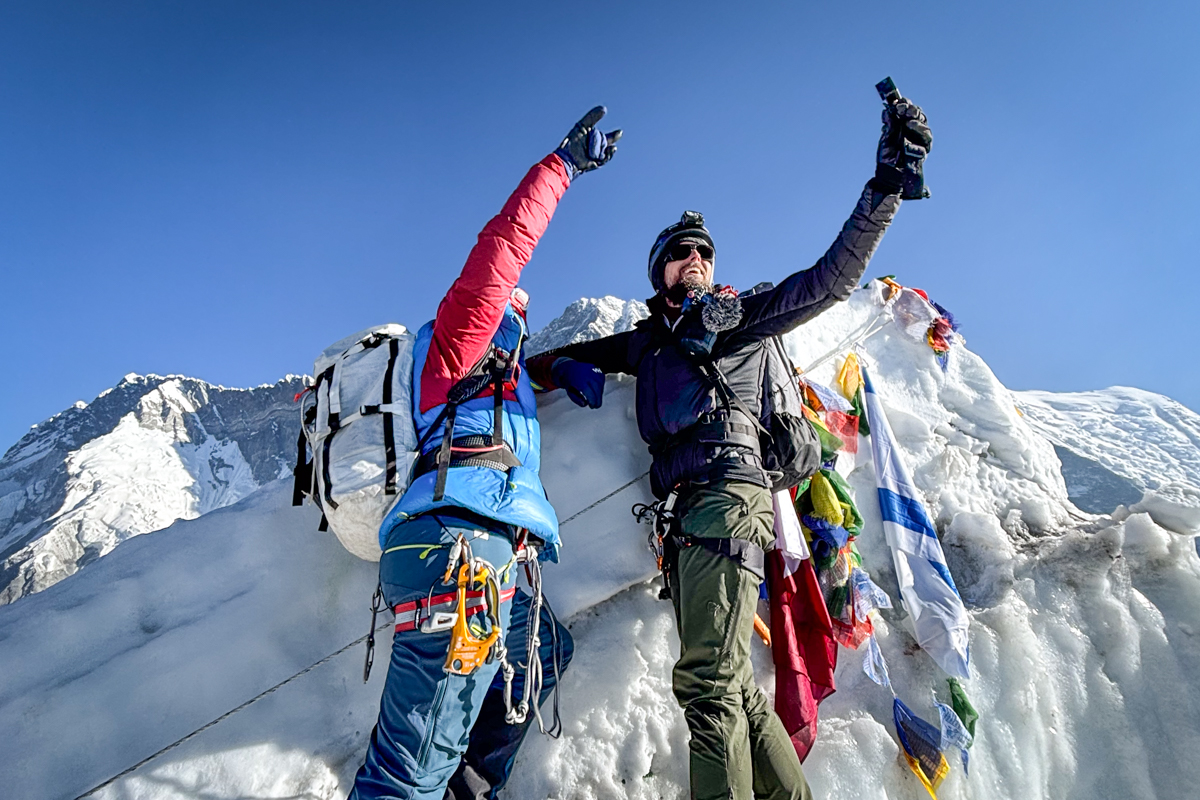
An important consideration when choosing a camera for hiking and backpacking is weather sealing. There isn’t a universal standard for weather sealing, but generally speaking, the joints and buttons of the camera body are covered and sealed with rubber to keep moisture out. Even with weather sealing, we definitely don’t recommend shooting in a sustained downpour or snowstorm, as water eventually can get through, but it can be very helpful in light to moderate precipitation. These seals also protect internal components from dust, trail grime, and oils from your hands that build up over time. If you’re a professional who shoots outdoors, it’s almost a must. When hiking in mist or light rain, we like to wrap our camera in our Buff or ziplock bag (with a hole cut out for the lens) while we carry it on our shoulder strap and shoot, which keeps water from worming its way into the cracks. Be sure to take it off once the Buff soaks through.
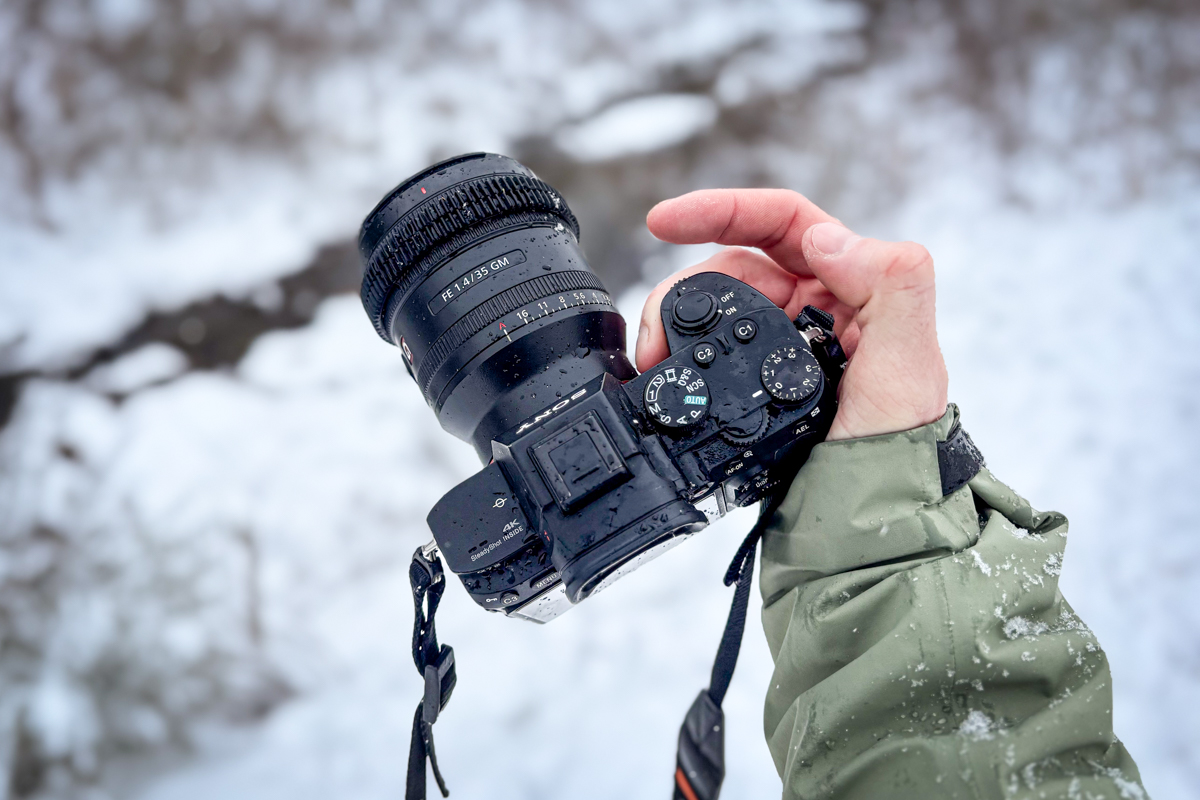
Aside from “tough” waterproof models and action cams, which are fun but not as competitive from an optical standpoint, point-and-shoots are generally not weather-sealed. Even with a high-end compact like the Sony RX100 VII, you don’t get this feature. In terms of DSLRs and mirrorless cameras, weather sealing is available on some mid-range models (like our top pick, Sony's a6700) and almost all full-frame models (like the popular Sony a7 IV). As a general rule, weather-sealed cameras are resistant to splashes of water and normal exposure to dust, but prolonged exposure can still significantly damage your device. They need to be handled with care and safely stored away when Thor's Hammer strikes.
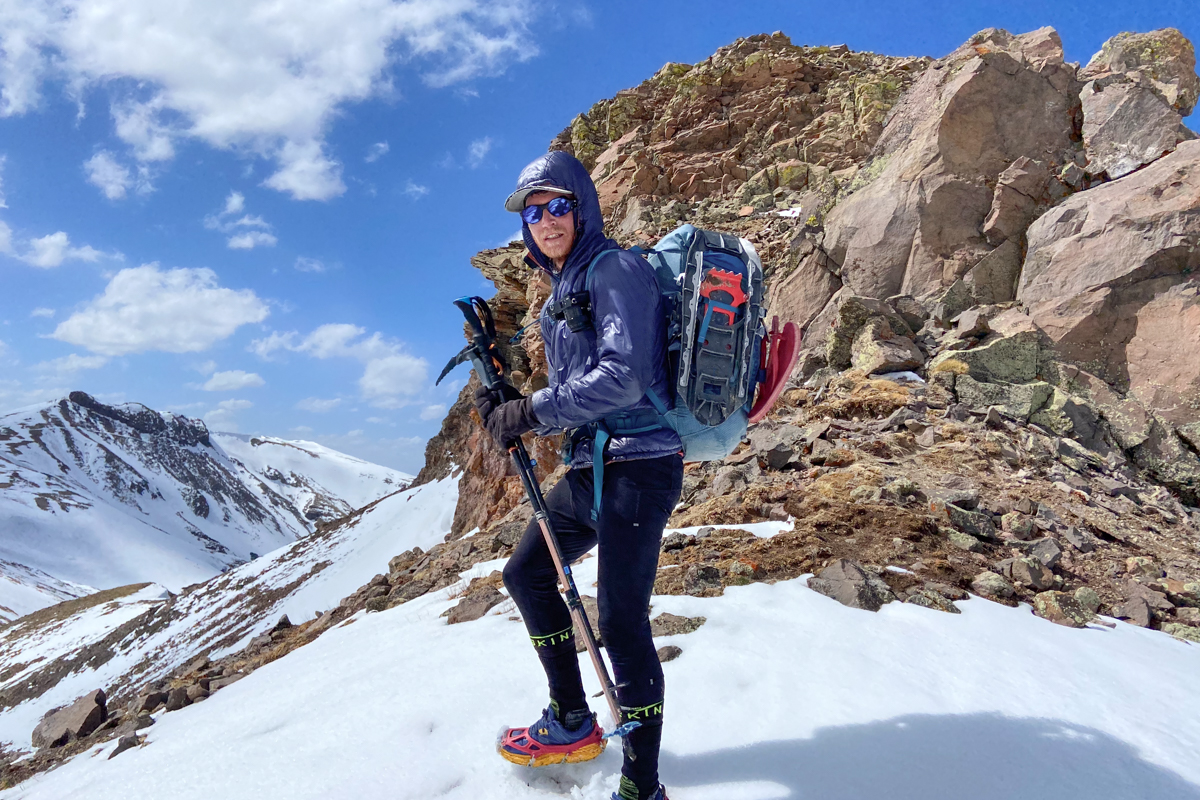
Durability and weather resistance often go hand-in-hand, but some models are undeniably built to handle more abuse than others. Obviously, "tough" models like OM SYSTEM's TG-7 can withstand the most torture, but we've accidentally dropped our Sony a6000 cameras from tripods, smashed them with our packs, and drug them along sharp rocks, and they surprisingly keep on kicking. We have found that Sony's APS-C and full-frame cameras are built to withstand more than their point-and-shoots. Our RX100 started to show significant wear by the end of an Appalachian Trail thru-hike—both electronically and physically—while our a6300 looked and performed like new (aside from the shutter button gumming up for several days).
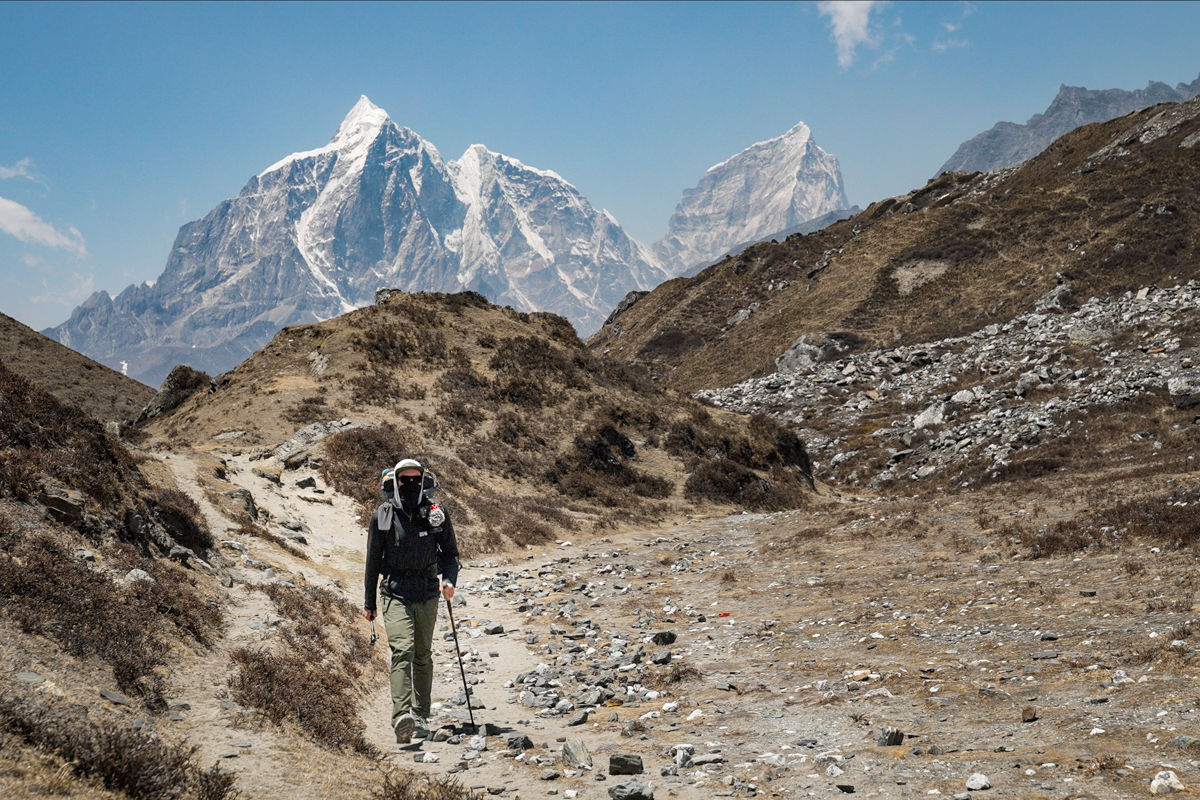
We haven't personally put enough quite miles on Nikon's or Canon's lightweight offerings, but our trail friends who have used them a lot report solid durability with models like Canon's PowerShot SX740 HS and PowerShot G7 X Mark III. One new Canon design we have been shooting with recently on trail is the EOS R50 V. We've been super impressed at this camera's durability and functionality in a tiny package. Even with durable builds, cameras are inherently more fragile than much of your backpacking kit, and need to be hauled and used with care (more on this in our "Carrying and Protecting" section). If you are overly concerned about damaging your device, we've seen some hikers put their cameras in a half or full cage (such as this SmallRig half cage for the a6700) as an insurance policy, but this adds weight and bulk.

You can also look into an actual insurance policy for your pricey tech, which we like to purchase when traveling internationally. Tech is sometimes covered by homeowner's insurance, but we usually pick up a separate travel insurance policy (our personal favorite is by World Nomads) that includes coverage for theft and damage to tech. In the end, treating your camera like the fragile glass it is will be your best defense against destruction.
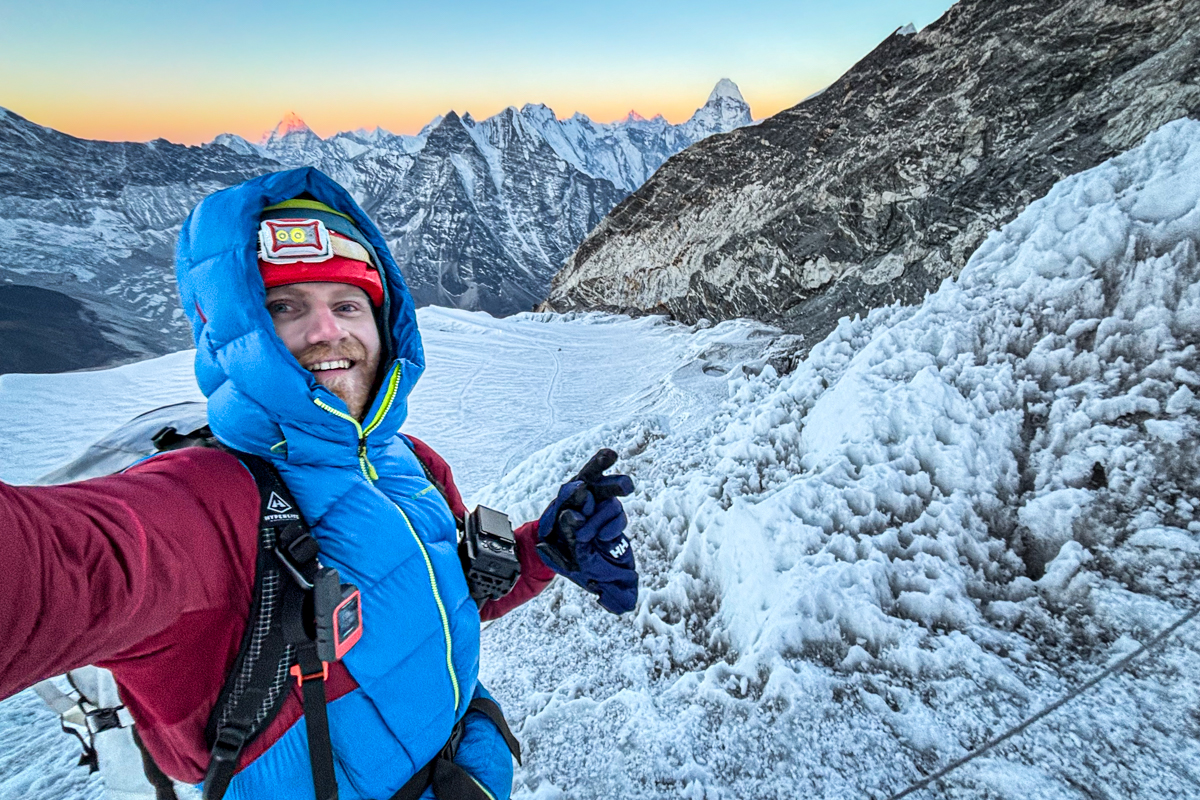
No matter which type of camera you choose, this small hunk of metal, plastic, and glass has to be carried in your daypack or backpacking pack—or on your shoulder—wherever you go. Therefore, trekkers are always looking for ways to shave ounces while still getting the photo quality they want. Hands down, our favorite mirrorless setup for anything from short weekend jaunts to full-blown thru-hikes is the 1 lb. 1.4 oz. Sony a6700, paired with Sony's 5.4-ounce E 35mm f/1.8 OSS lens, and two extra Sony NP-FZ100 batteries (3 oz. each). We also carry at least a 15,000 mAh battery bank. This puts our base camera rig (body, lens, three batteries, and card) at 1 lb. 13 oz.—a worthwhile weight penalty for what this tiny beast can accomplish. If you aren't shooting much video, you could get away with two batteries, unless you'll be away from town for more than a week.

Point-and-shoots are the lightest of all camera options, starting at around 9 ounces for a competitive model. As discussed above, they also have the smallest sensors and lenses. Moving up to interchangeable-lens cameras, mirrorless models hover around 1 lb. 1.4 oz. for the camera body (like Sony's a6700) to 1 lb. 4.8 oz. or more for full-frames like Sony's a7 IV. DSLRs are the heaviest of the bunch, ranging from 13 ounces to 2 pounds for something like Nikon's D850. Depending on which lenses you choose and how many, you should expect your interchangeable lens set-up to weigh from around 2 pounds at the low end up to 5 pounds or more for a full-frame camera with multiple lenses. For the whole package with less performance chops, it's hard to beat the ultralight, ultra-packable 10.7-ounce RX100 VII point-and-shoot.
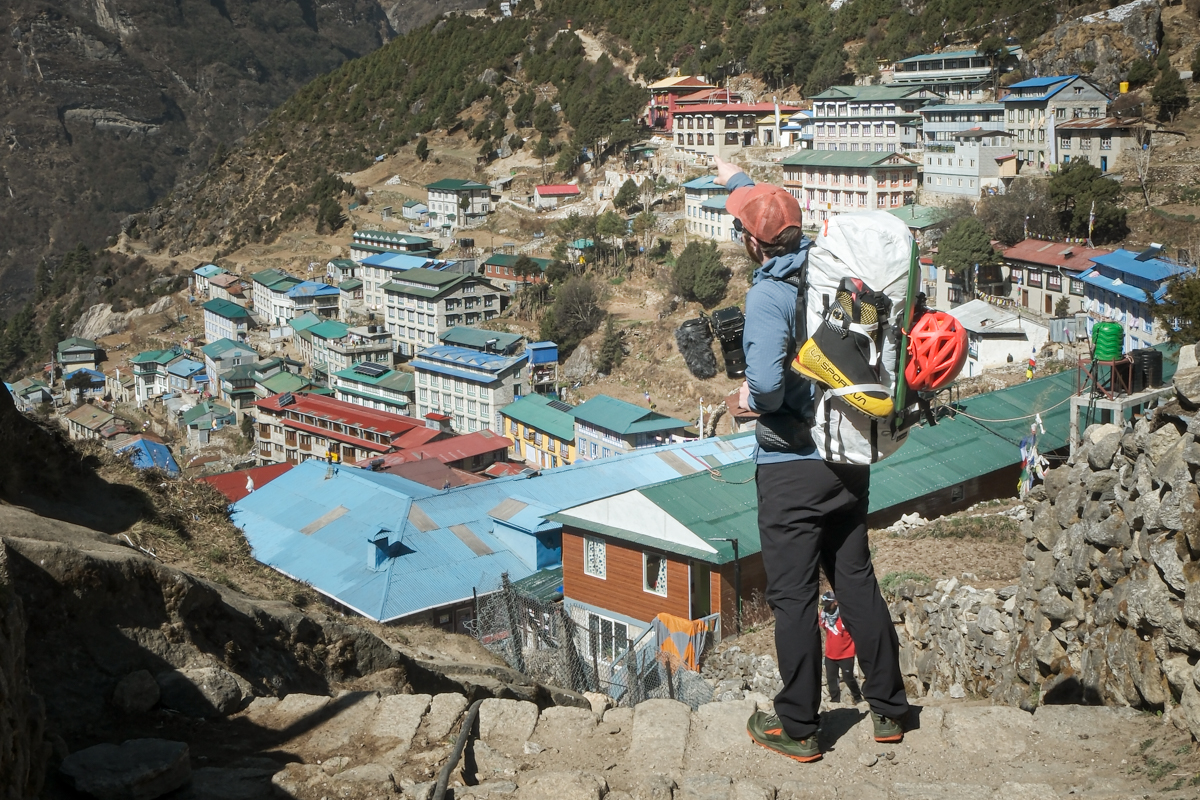
Here’s our take: Get the camera you want—keeping weight in mind—but don’t fret over it too much. There are no shortcuts to capturing great photos or videos in the wilderness. You either bring nothing or your phone and get content that is mediocre at best, or you add a little weight to your bag and get professional-grade images that can be framed and hung on your wall for a lifetime. We’ve known a number of professionals who keep trying to go lighter and smaller but end up back with the full-frame brick in their pack. At the end of the day, it’s worth it for those who have a serious interest in photographing or filming their journey.
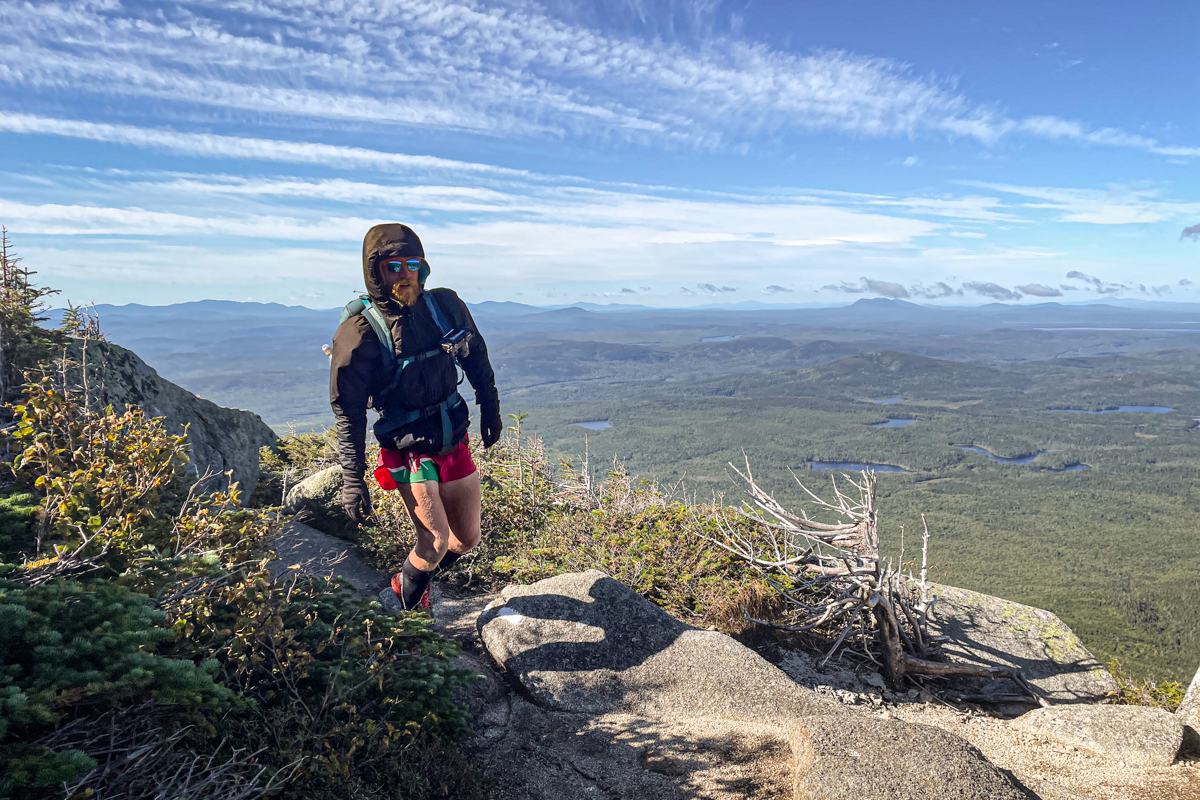
One of the beauties of bringing a proper camera into the backcountry is the level of customization and control you get over your content. Learning how to properly use a camera in manual mode can take years of practice—and isn't for everyone—but will allow you to get otherworldly shots as you rack up unforgettable memories in the wild. Below, we briefly outline some key technical features to consider when shopping for a capable hiking camera.

Sensor Size and Megapixels
In the most rudimentary sense, camera sensors are internal surfaces that capture light and convert it into an electronic signal, which is processed by the camera to create an image. A CMOS (Complementary Metal Oxide Semiconductor) sensor is one of the most common ones you'll find on modern cameras. These come in different designs and sizes. The most common sensor sizes are full-frame (36mm x 24mm), crop-sensor APS-C (around 22mm x 15mm or 23.6mm x 15.6mm), and micro four thirds (around 18mm x 16mm).

Full-frame models, like the Panasonic Lumix S9 (pictured above), offer the best image quality, low-light performance, dynamic range, and noise control but often run on the larger side. APS-C and micro four thirds cameras can't capture as much light as full-frame cameras, but still produce quality images and are great for keeping weight and bulk down while hiking. The megapixel (MP) count of the sensor impacts the quality of your content. More megapixels translate to more image detail, editing abilities, and cropping freedom. We generally like to shoot with cameras that have at least 20 MP (such as Sony's 26 MP a6700), but lower-quality point-and-shoots will get the job done if you don't plan to do much with your content in post.
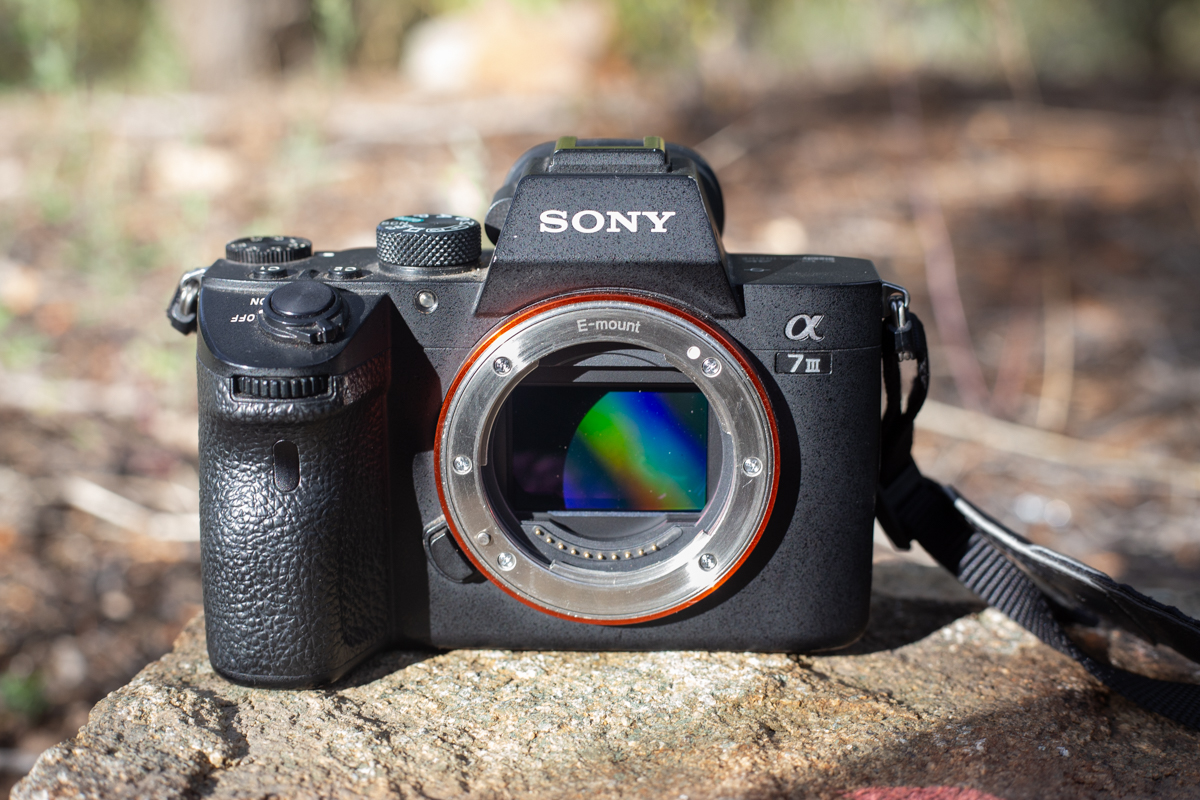
ISO Sensitivity
The ISO (International Organization for Standardization) range of your device indicates the camera's sensitivity to light as a numerical value. ISO works in tandem with aperture and shutter speed to properly compose an image in variable lighting. This is an important element to master in the backcountry, as you are at the mercy of the sun and won't be lugging any fancy lighting rigs with you. Low ISOs are best for shooting in harsh midday light (or bright snow), and higher ISOs allow you to shoot in low light, such as late evening or night. Try to keep the ISO as low as possible, using aperture, shutter speed, and neutral density (ND) filters to help manage exposure, since higher ISOs add graininess and noise. ND filters are more necessary with video, but can help when photographing bright environments with harsh highlights, such as winter scenes in the snow.

Cameras with broader ranges (like the ISO 50-204,800 extended range of Sony's a7C II) afford more flexibility in both harsh- and low-light situations. It's important to note that the “extended” ISO range is a digitally enhanced expansion on top of the base (or "native") ISO. While it can be pushed to the "extended" end of the spectrum, the expanded range is enhanced in-camera and will often produce a lower-quality image. Keep this in mind when you see the extended ISO range broadcasted on product pages. Sticking within the native range will give you the best results.

Aperture
Aperture is essentially the opening in a lens through which light passes. Aperture greatly impacts exposure and depth of field (how much of the image is in sharp focus). Larger—also known as "faster"—apertures are expressed as smaller numbers (e.g., f/1.4), and allow you to shoot in lower light since they allow more light in. This also adds greater background or foreground blur called "bokeh". Smaller apertures (e.g., f/16) let less light in, put more of the image in focus, and are helpful for shooting in harsh light. We prefer lenses with the capability to shoot at fast apertures of at least f/1.8, and smaller apertures of f/16 on trail—though ultralight lenses, zooms, and point-and-shoots don't always afford us this luxury.
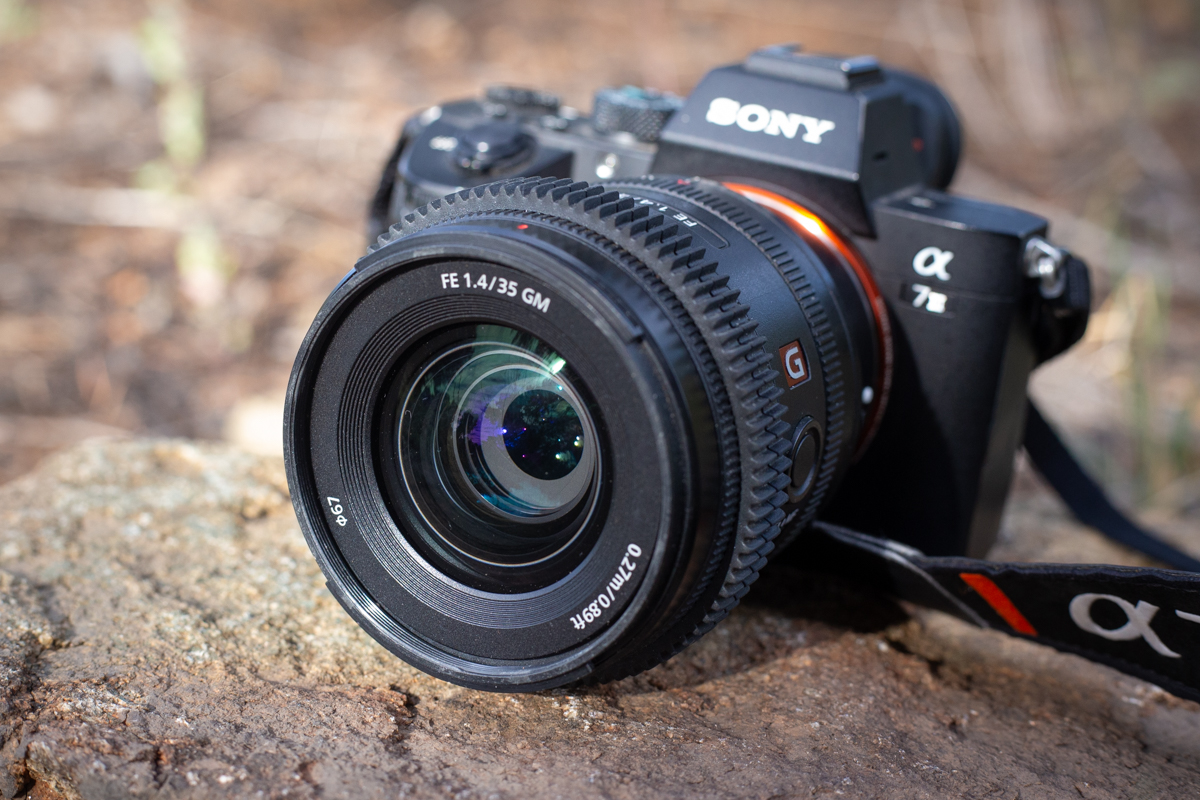
Video Capabilities
The video-specific specs of modern lightweight cameras vary wildly, and range from Netflix-worthy cinema models like Sony's FX30 to photo-specific designs like Ricoh's GR III HDF, capable of just the basics. If you only want the occasional clip to show friends and family, something like the latter may suffice. But if you plan on filming a significant portion of your trek, you'll want something with more prowess. In the most basic sense, we tend to only carry cameras that shoot at least 10-bit 4K video up to 60 frames per second (fps). Higher frame rates allow you to slow down or speed ramp footage in post and afford more flexibility in composing your shots.
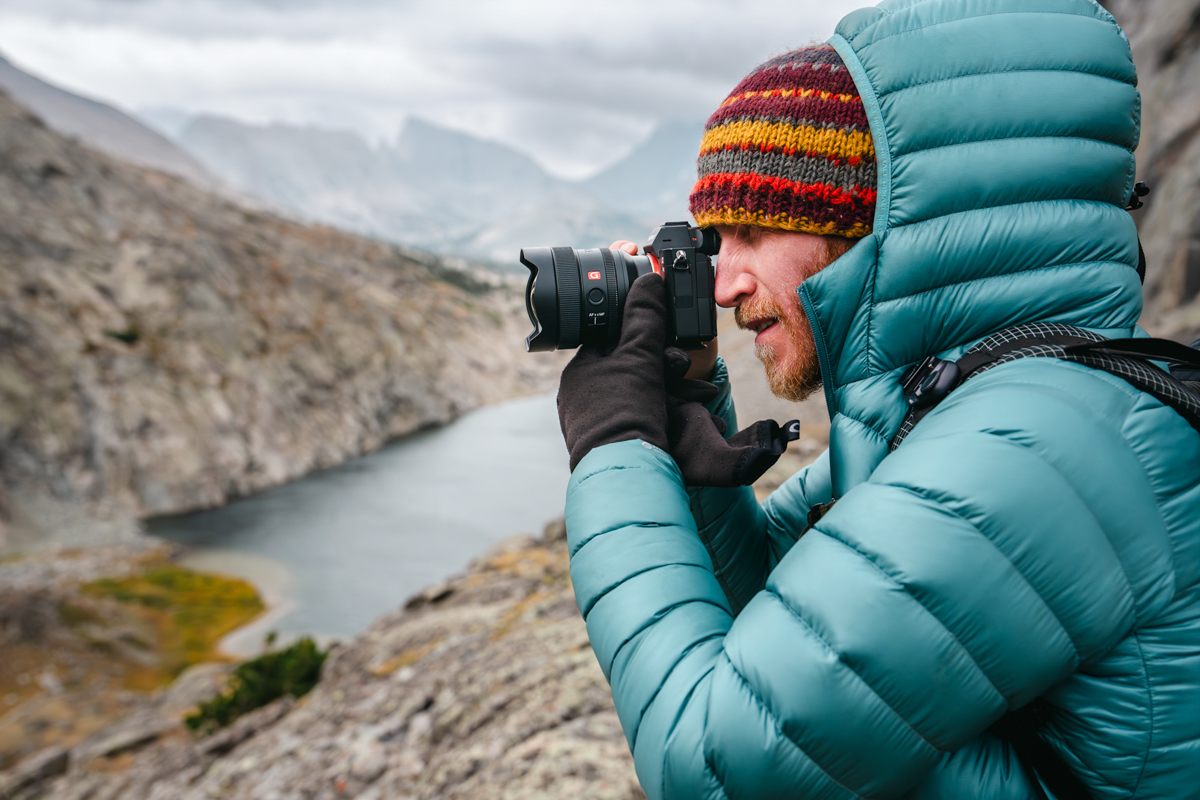
Higher resolutions (4K, 6K, etc.) and bit rates (8-bit, 10-bit, etc.) pack more information into a clip, giving you greater manipulating power over your footage when editing. Higher resolution shots do take more space on your SD card, which is an important consideration on a long backpacking trip. Most cameras with pro-level video specs will also have the ability to shoot in flat picture profiles (such as Sony's S-Log3), affording more color grading freedom in post. Keep in mind that you want to maintain a shutter speed that correlates with your chosen frame rate when shooting video (1/50 if shooting at 24 fps, 1/120 if shooting at 60 fps, etc.), so you can't rely on shutter speed to help adjust exposure. For that reason, we always carry a variable neutral density filter (VND), such as Polar Pro's PMVND (1.4 ounces), to help while shooting in harsh midday light.
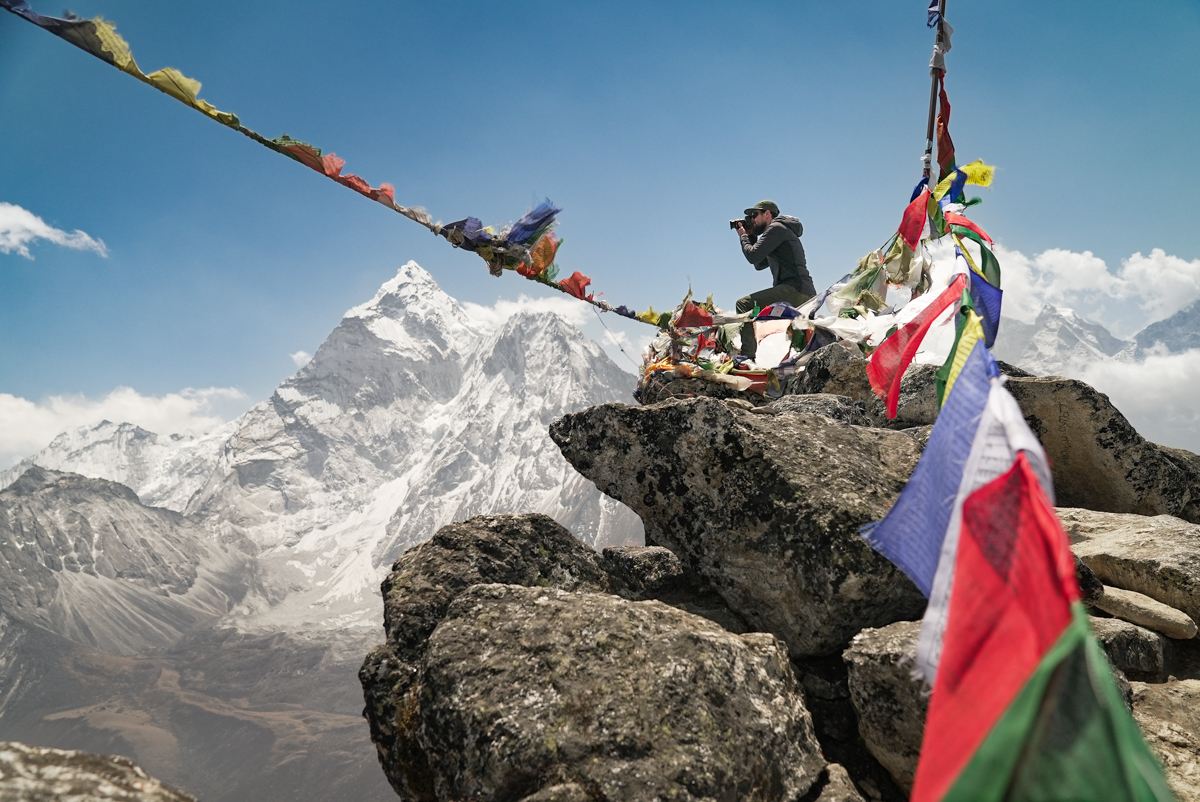
Another consideration when filming on trail is the on-board mic quality of your camera. For basic ambient sound, the built-in mic of your camera may suffice, but if you want to pick up higher-quality audio, or are doing any interview work, a separate mic is a must. To use these, ensure your camera has a mic port and, optimally, a separate headphone port for monitoring live audio levels. Mics can get heavy and bulky fast, so we recommend going with just the basics on a backpacking trip (and one that doesn't require separate charging). Our favorite ultralight mic is the 0.3-ounce Boya M100. It weighs nothing and gives you passable audio in a minuscule size. For a bump in quality, the 1.4-ounce RODE VideoMicro II delivers crisp results for how small and compact it is. Wind noise is often unavoidable on trail, so we recommend minimizing chatter with a dead cat windshield for your specific mic.
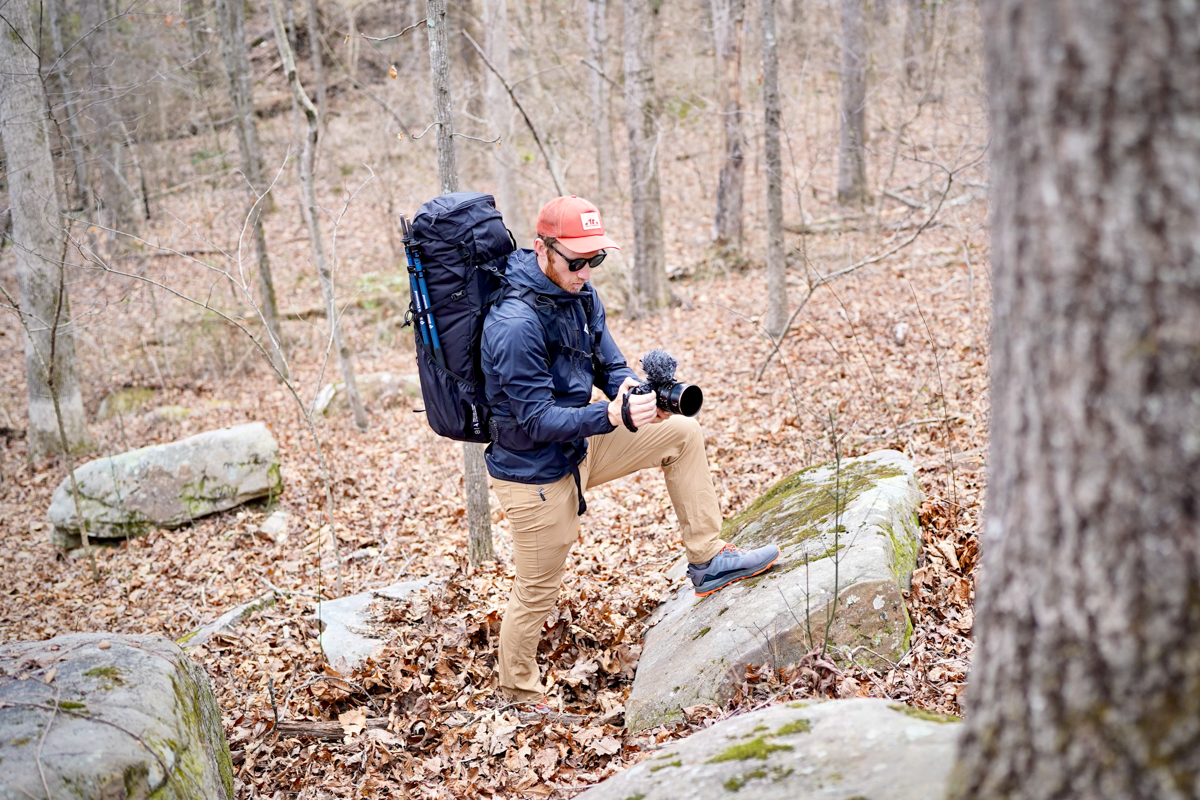
LCD Screen Configuration
As vlogging, selfies, and capturing solo backpacking trips becomes more and more common, camera companies have risen to the challenge with LCD screens that can tilt 180° so you can easily view it while looking at the camera. In general, smaller modern APS-C cameras feature more versatility and tilt in their LCD screen than their bulkier full-frame counterparts. Some buck this trend, however, like the impressively light and compact Panasonic Lumix S9, with a 3.0" Tilt/Free-Angle Touch-LCD that swivels out to the side and can be flipped around to view from the front. This is becoming more and more common (even the clunky Sony FX3 has this capability), but other mainstream full-frame models, like the Sony A7 III, only allow a small amount of tilt from the back (the latest A7 IV swapped to the same configuration as the FX3, though).

Wifi and Bluetooth Connectivity
A helpful feature for cameras on hiking or backpacking trips is its ability to transfer photos wirelessly to smartphones. This allows you to quickly send pictures to family and friends, clear up space on your SD cards, or seamlessly share your content on social media. While many prefer pulling files from their cameras this way, we tend to carry a lightweight SD card reader while backpacking—even if our camera has the ability to share content wirelessly. A card reader affords faster transfer speeds (especially for videos) and often transfers higher-resolution copies of files to your phone. However, card readers malfunction easily in harsh environments (from our experience), so having the ability to transfer everything via Wifi or Bluetooth is a handy backup.
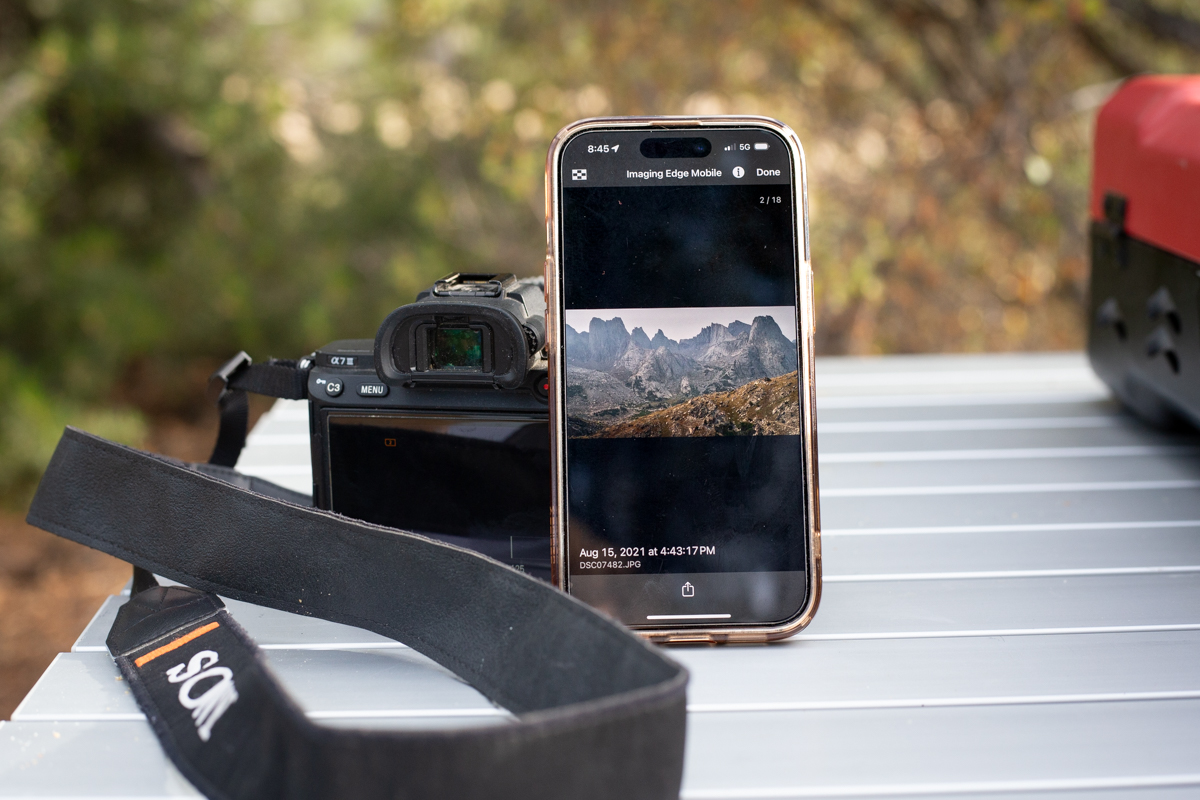
In terms of point-and-shoots, keep an eye on the listed zoom range. Most are 24mm at the wide end or narrower, which is serviceable but not optimal for landscape photography—one compromise of going with a point-and-shoot on trail. The truth is that in 2025, there are few point-and-shoots with true wide-angle lenses, although the iPhone 15 Pro has three lenses, one of which is equivalent to an impressive 13mm (albeit at a lackluster 12 MP). Point-and-shoots have fixed lenses, but interchangeable lens cameras offer endless focal length possibilities for different scenarios. If we aren't too concerned about weight on a shorter hike or are doing a lot of run-and-gun documentary work, we love pairing our full-frame (or APS-C) Sony with the versatile FE 24-70mm f/2.8 GM II lens (with a wider ultralight lens in our back pocket). It's big and heavy (1 lb. 8 oz.), but composes striking photos, is great for video, and features Sony's premium GM glass.
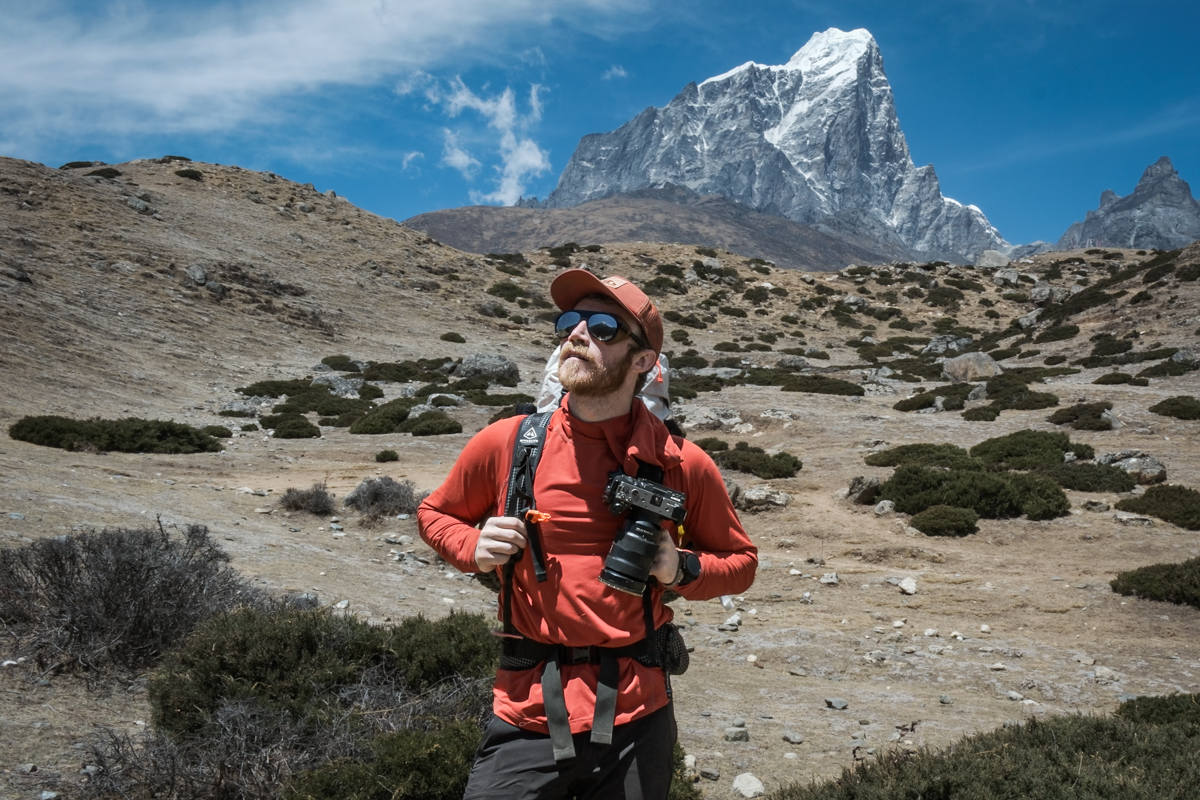
Fixed focal-length lenses are referred to as "prime lenses", and are generally lighter and more compact than zoom lenses. They also tend to have faster apertures. For ultralight backpacking and thru-hiking, our go-to combo is Sony's a6000 series with the tiny prime E 35mm f/1.8 OSS lens. We love its wide aperture, mini size, and the 35mm focal length on an APS-C sensor (making it the full-frame "nifty fifty" equivalent of 52.5mm). It also features Optical SteadyShot (OSS), a lens-based stabilization that adds extra stability to videos and photos. It's a hard one to beat and clocks in at a scant 5.4 ounces. The obvious downside here is the lack of telephoto or wide-angle capabilities.

When buying lenses for your mirrorless camera or DSLR, make sure to identify the 35mm equivalent. Most DSLRs and mirrorless cameras of the APS-C variety are offered with 18-55mm kit lenses, which are equivalent to 27-82.5mm for Nikon and 29-88mm for Canon, for example. This means that for the best hiking photos, you’ll almost certainly want to add a true wide-angle lens. Yes, it adds cost and weight to the mix, but the final product will be substantially better both in terms of field of view and image quality. Wide pancake lenses add minimal weight and bulk to your kit, such as Sony's E 16mm f/2.8 ultra-wide 2.4-ounce prime (full-frame equivalent of 24mm). If you can only bring one lens, however, our personal favorite for versatility is the "nifty fifty" 50mm focal length. For more on this topic, including matching lenses to your specific camera, see our detailed lens reviews and our guide on lenses and focal lengths for landscapes.

Cameras and lenses are inherently fragile and expensive. Even "tough" models like OM SYSTEM's TG-7 have their limits. It's important to develop a system of carefully carrying your device and protecting it from the elements, without making it too difficult to whip it out of your pack for a spontaneous pic. When carrying our cameras inside our packs, we stash them in a neoprene case specific to the camera body and lens or a padded camera cube. While hiking in fair weather, something like Peak Design's Capture Clip is invaluable. These clips allow you to carry your camera on your front, securely attached to a backpack shoulder strap, and slide it off the strap in seconds.
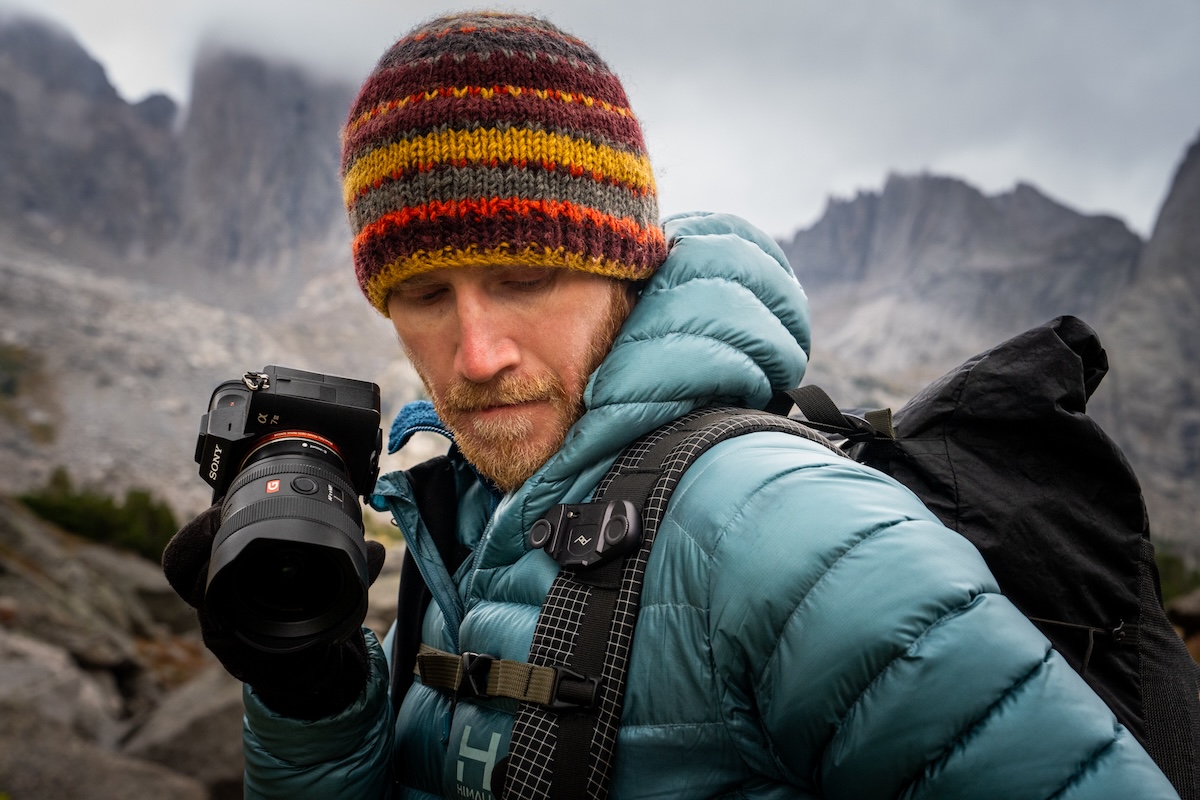
Our favorite cube for medium to large cameras is Lowepro's GearUp PRO Large II Camera Box. It allows us to store at least two small lenses, the camera body, and a few accessories. Peak Design's Camera Cubes V2 are also great choices, which mesh seamlessly with any Peak Design pack but are versatile enough for most backpacking backpacks. In the case of rain, we put the whole package in a roll-top dry bag, or just line our bag with a pack liner (or both). Two of our favorite waterproof pack liners are Nylofume bags, such as this one sold by Garage Grown Gear, and polyethylene bags, such as this one from Gossamer Gear. Both are fantastic, durable alternatives to trash bags or rain covers, and we have used each to protect sensitive camera gear on long thru-hikes.
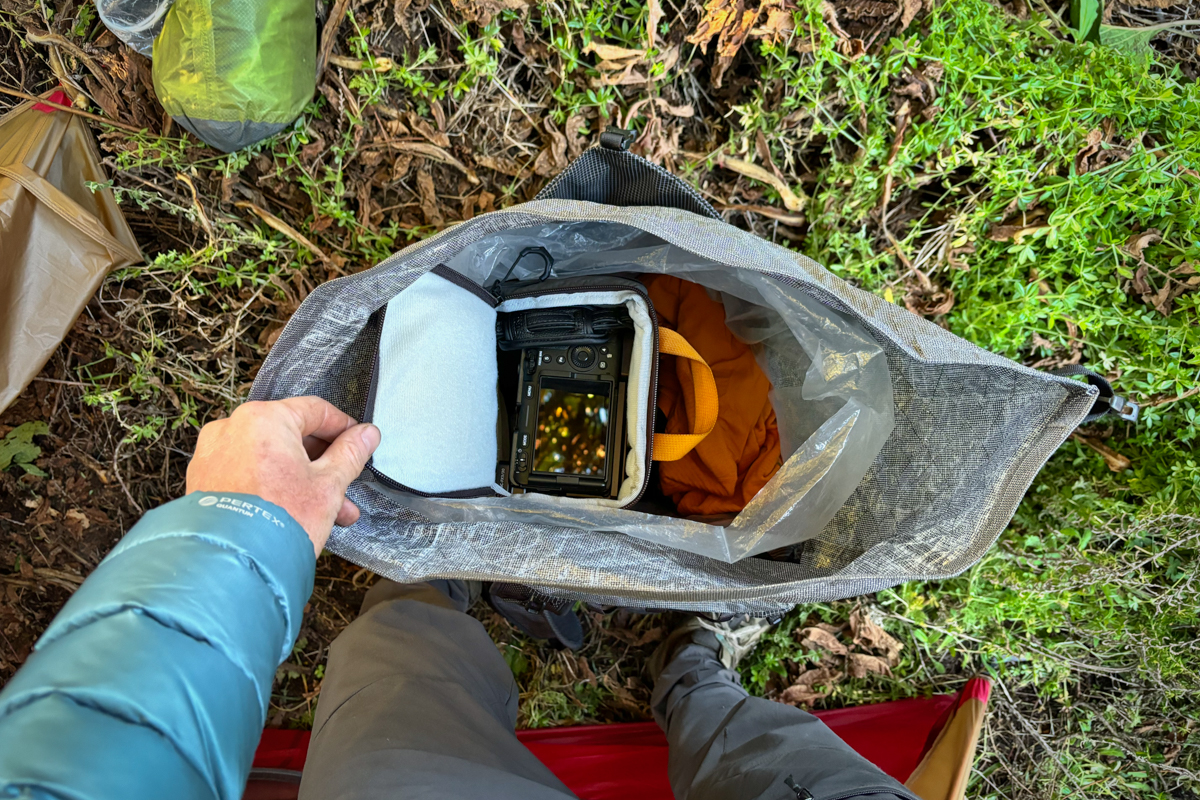
As hauling high-end cameras on hiking or backpacking trips has swelled in popularity, certain brands have developed both day hiking and backpacking backpacks specifically crafted to carry sensitive cameras and lenses. For light day hiking in mild conditions, our favorite packs in this category include Peak Design's Everyday Zip 20L and Thule's Covert 32L. For more technical, rugged day hiking, check out Lowepro's Flipside Trek BP 450 AW. For multi-day trips, fully featured backpacking backpacks like AtlasPacks' Athlete or Moment's Strohl Mountain Light (pictured below) are stellar solutions for protecting cameras, lenses, mics, and more on long treks.
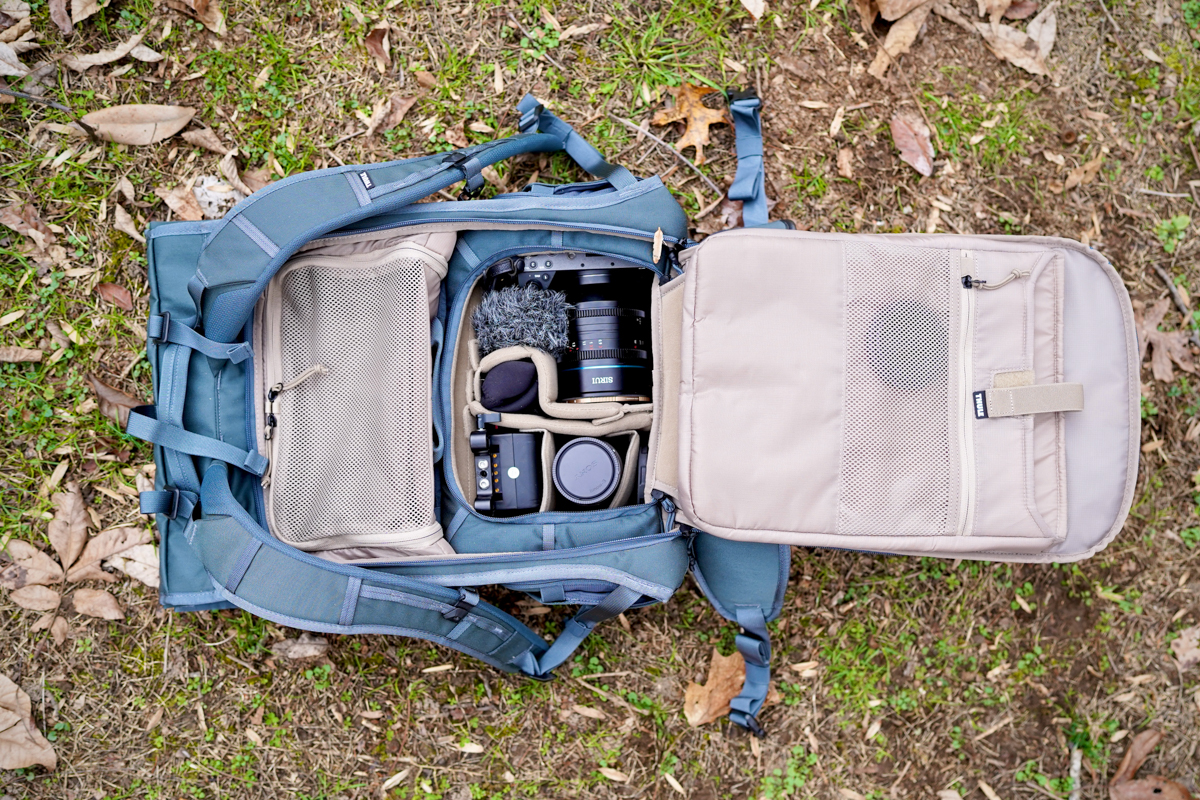
These backpacks are expensive and heavy, though, and regular or ultralight backpacking packs work just fine with the right equipment. For dedicated ultralight backpackers and thru-hikers, we would recommend just using your backpack of choice and storing your camera in a lightweight neoprene camera case (or camera cube if you have several lenses), protected by a small dry bag and pack liner when it rains, with a Peak Design Capture Clip for hauling on your shoulder strap in good weather. Stash sensitive accessories (spare batteries, small mics, SD cards, etc.) in a sturdy Ziplock within the dry bag. This lightweight system has kept our precious glass and tech safe for thousands of miles through driving whiteouts and weeks of endless rain alike.
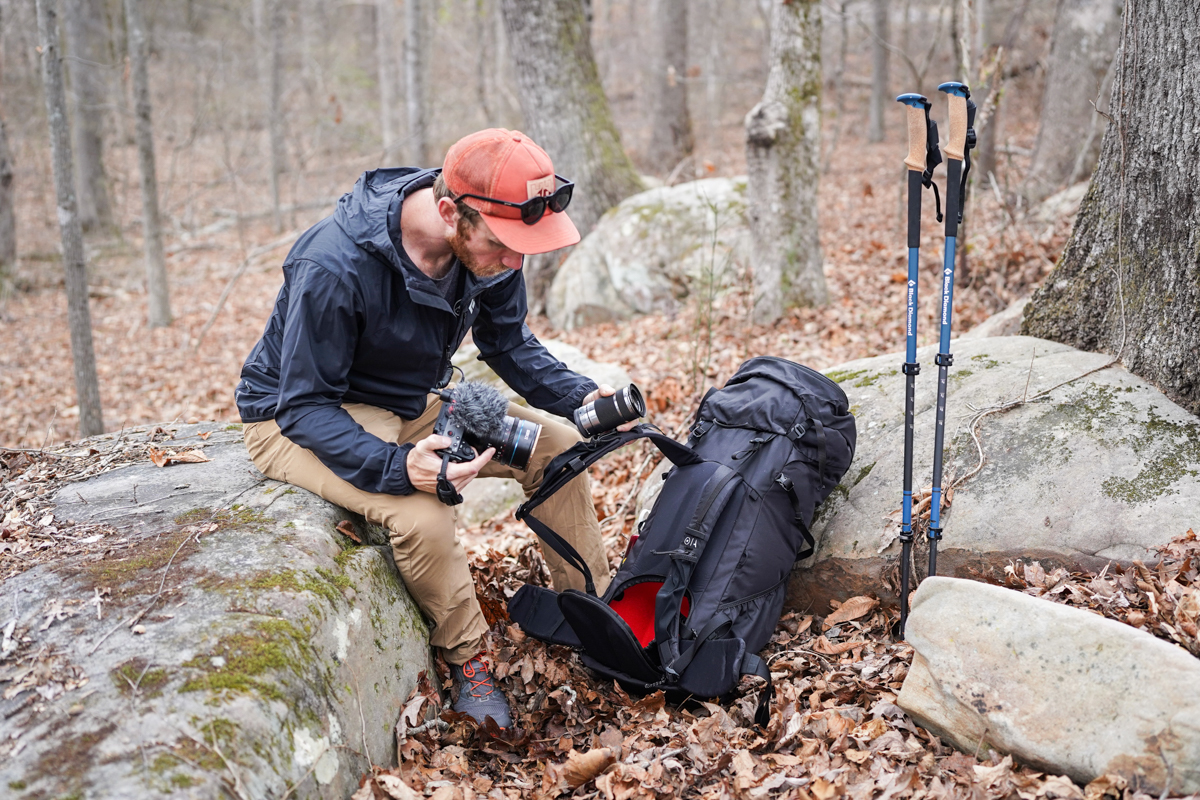
Carrying Cameras with Camera Straps
For shorter day hikes, or while trotting around town mid backpacking trip, simply throwing a camera strap on your device may suffice. Even on some longer backpacking trips (especially when we are hauling heavy, bulky rigs), we like to keep a strap on our camera slung around our neck while it's attached to our Peak Design clip as an added safety measure, and so it stays securely attached to us when we unclip it to take a photo. We especially like this method on mountaineering or climbing trips when we have a camera clipped to a climbing pack.

Most camera straps that come with the camera have adequate padding, but there are a plethora of aftermarket straps with extra padding for carrying heavier cameras long distances around your neck, like this one. We also love the versatility of Peak Design's Slide Lite Strap, which allows you to quickly add or remove the strap mid-trek. Finally, another lighter method of safely holding your camera when in use is to throw a hand strap on the shutter side of the camera, which greatly reduces the risk of dropping your device. We've been using Peak Design's Micro Clutch for several months now on all sorts of backcountry missions, with great results. It also pairs seamlessly with PD's capture clip. This method saves some weight, but isn't as safe as a dedicated strap around your neck.

An old saying in photography is, “The best camera is the one you have with you.” When choosing a camera for hiking, make sure to pick an option that will be accessible. Professional photographers are willing to stop and take the time to whip out their DSLR or mirrorless interchangeable-lens camera for a shoot, but having a complicated set-up can equate to fewer photos (and, therefore, fewer good photos).
Optimally, you have a camera like the Ricoh GR III in a side pocket or hip belt and a more serious mirrorless camera or DSLR in your backpack. That way you don’t miss the fleeting photo opportunities but can unpack the heavy artillery for epic shots or when you’re already stopped. Regardless of your hiking camera choice, make sure to have it accessible enough that you’re using it. The best photos often aren’t anticipated.
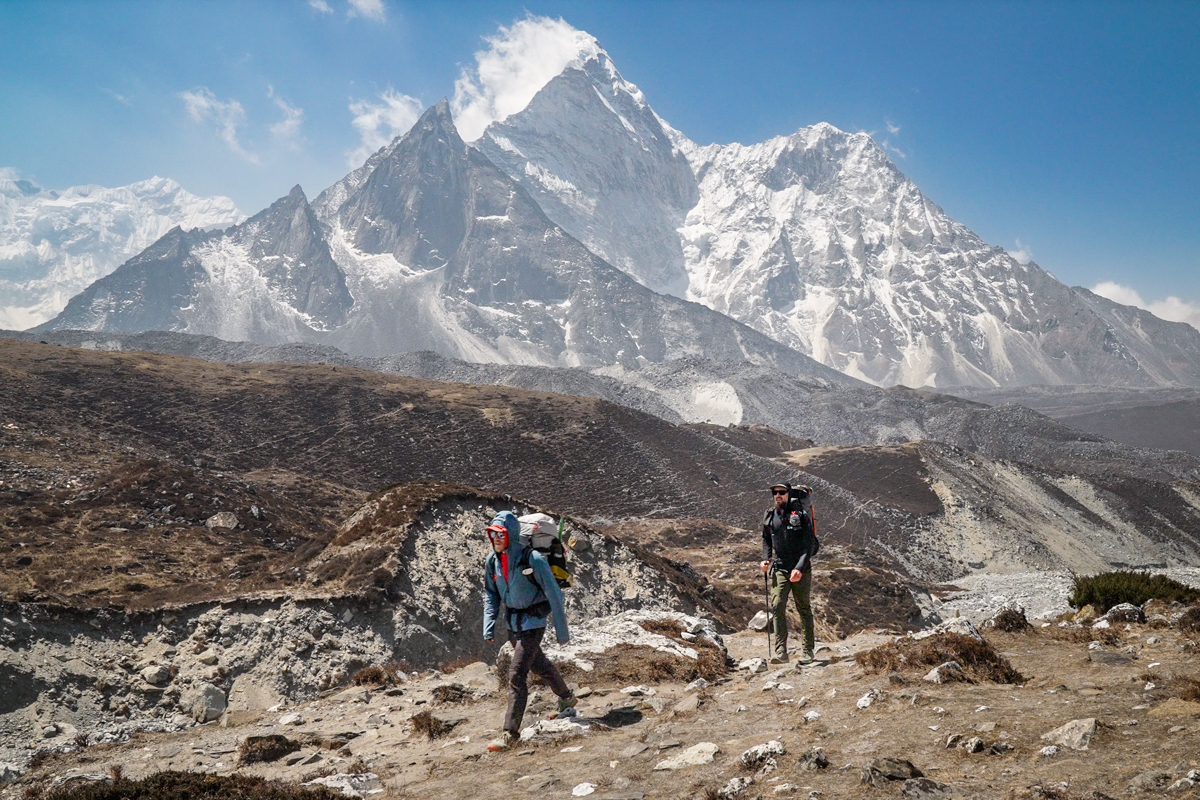
Back to Our Top Cameras for Hiking Picks Back to Our Cameras for Hiking Comparison Table